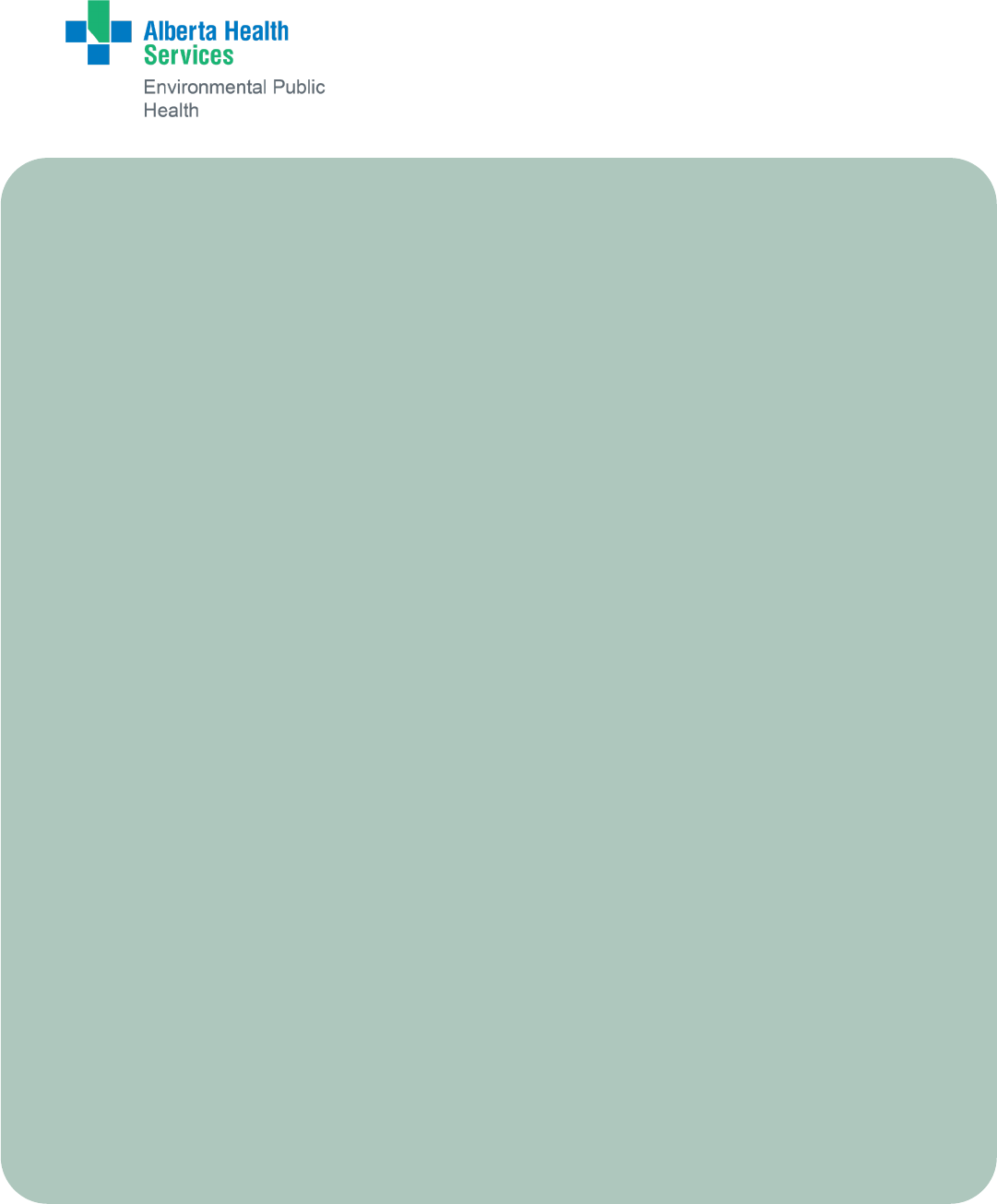
Health and Safety Guide for
Operators of Child Care Facilities
May 2024

Health & Safety Guide for Operators of Child Care Facilities
2
Safe Healthy Environments - Environmental Public Health – May 2024
Revision History
Date
Summary of Revisions
May 2024
- Updates to First Aid Operational Requirements
This public resource has been prepared by Environmental Public Health, Alberta Health
Services.
PUB-0394-202405
Contact
For more information, please call Safe Healthy Environments at 1-833-476-4743, or submit a
request online at ahs.ca/eph.
© 2024 Alberta Health Services – Safe Healthy Environments
CC BY-NC-SA 4.0
This work is licensed under a Creative Commons Attribution-Non-commercialShare Alike 4.0 International license
. To view a copy of this licence, see
https://creativecommons.org/licenses/by-nc-sa/4.0/ . The licence does not apply to AHS trademarks, logos or content for which Alberta Health Services is not the
copyright owner.
This material is intended for general information only and is provided on an "as is", "where is" basis. Although reasonable efforts were made to confirm the
accuracy of the information, Alberta Health Services does not make any representation or warranty, express, implied or statutory, as to the accuracy, reliability,
completeness, applicability or fitness for a particular purpose of such information. This material is not a substitute for the advice of a qualified health professional.
Alberta Health Services expressly disclaims all liability for the use of these materials, and for any claims, actions, demands or suits arising from such use.
Health & Safety Guide for Operators of Child Care Facilities
3
Safe Healthy Environments - Environmental Public Health – May 2024
Table of contents
Introduction ........................................................................................................................................................................................ 4
Regulations ....................................................................................................................................................................................... 5
Requirements for Building Design & Materials ................................................................................................................................... 6
Approval of Construction & Renovation Plans .............................................................................................................................. 6
Floors, Walls & Ceilings................................................................................................................................................................ 6
Plumbing & Sinks ......................................................................................................................................................................... 6
Water Temperatures .................................................................................................................................................................... 7
Sewage System ........................................................................................................................................................................... 7
Washrooms .................................................................................................................................................................................. 8
Heating & Indoor Air Quality ......................................................................................................................................................... 8
Stairways & Walkways ................................................................................................................................................................. 9
Windows and Doors ................................................................................................................................................................... 10
Lighting ...................................................................................................................................................................................... 11
Designated Areas ....................................................................................................................................................................... 11
Storage Space ........................................................................................................................................................................... 12
Sleeping ..................................................................................................................................................................................... 13
Sick Child Area ........................................................................................................................................................................... 13
Laundry Area.............................................................................................................................................................................. 13
Operational Requirements ............................................................................................................................................................... 14
Food Handling ............................................................................................................................................................................ 14
Diapering .................................................................................................................................................................................... 15
Personal Hygiene ....................................................................................................................................................................... 16
Communicable Disease Outbreak Management ......................................................................................................................... 19
Sleeping ..................................................................................................................................................................................... 20
Play Equipment .......................................................................................................................................................................... 21
First Aid ...................................................................................................................................................................................... 23
Equipment & Safety .................................................................................................................................................................... 23
Maintenance & Cleaning ............................................................................................................................................................ 23
Laundering ................................................................................................................................................................................. 24
Garbage ..................................................................................................................................................................................... 24
Biomedical Waste ...................................................................................................................................................................... 25
Animal Care and Control ............................................................................................................................................................ 25
Resources .................................................................................................................................................................................. 27
Appendix A - Food Safety Recommendations for Child Care Facilities with 10 or Less Children ...................................................... 28
Appendix B – Diapering Procedure .................................................................................................................................................. 30
Appendix C - Surface Cleaning & Disinfection Guidelines for Outbreaks in Child Care Facilities ...................................................... 31
Appendix D – Crib Safety Checklist ................................................................................................................................................. 32
Appendix E – Arts & Crafts Safety ................................................................................................................................................... 33
Appendix F - Cleaning & Disinfecting Surfaces, Equipment & Toys ................................................................................................. 35
Appendix G – Cleaning & Disinfecting Schedule for Child Care Facilities ......................................................................................... 36
Appendix H – First Aid Equipment & Supplies.................................................................................................................................. 39
Appendix I – Cleaning & Disinfecting Blood Spills, Feces, Vomit & Other Body Fluids ..................................................................... 42
Appendix J – Additional Guidelines for Day Homes ......................................................................................................................... 44
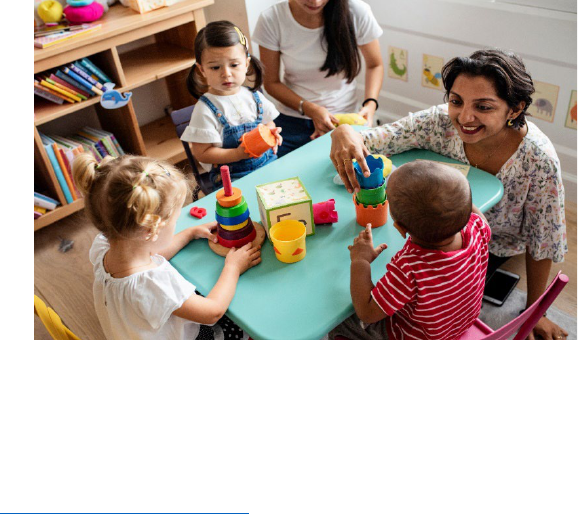
Health & Safety Guide for Operators of Child Care Facilities
4
Safe Healthy Environments - Environmental Public Health – May 2024
Introduction
This guide is for operators of
daycares, pre-schools, before
and after school care programs,
group family child care, casual
drop off childcare, and similar
services. It describes health and
safety requirements in Alberta’s
regulations, and
recommendations from Alberta
Health Services’ (AHS)
Environmental Public Health
(EPH) program.
Following the regulations and recommendations will help to protect children from getting
hurt or sick in child care settings. If you have specific questions regarding your child
care business contact your local public health inspector (PHI). Contact information can
be found on the EPH website at https://www.ahs.ca/eph.
Children can be vulnerable to infections in child care settings because they:
• play, touch, and interact with
many other children
• put objects in their mouths
• have developing immune
systems
• may not wash their hands
properly, which can spreads
germs to surfaces and food
• share the space with other
diapered children
Children are more vulnerable to injury because their bodies and brains are developing:
• they don’t understand
hazards, still learning limits,
less coordinated etc.
• children’s lungs are sensitive to
polluted air, which can be 2 to 5
times higher indoors than
outdoors
Rawpixel.com/shutterstock.com

Health & Safety Guide for Operators of Child Care Facilities
5
Safe Healthy Environments - Environmental Public Health – May 2024
Regulations
In addition to the content in this guide, you should be familiar with these regulations
from Alberta’s Public Health Act that apply to your child care business. You can find
these regulations on the Alberta King’s Printer’s website at:
https://www.alberta.ca/alberta-kings-printer.aspx
These regulations include:
Communicable Diseases Regulation
• applies to all child care facilities
Food Regulation
• applies to any child care facility
that provide food service to more
than 10 people
Institutions Regulation
• applies to all child care facilities
Housing Regulation
• applies to child care facilities
which provide living
accommodation, including
sleeping facilities
Public Swimming Pools Regulation
• applies to any child care facility
that has a swimming pool, hot tub
or wading pool
Nuisance and General Sanitation
Regulation
• applies to all child care facilities
Roles & Responsibilities
PHIs must inspect child care facilities, enforce regulations, investigate complaints, and
provide guidance to child care operators, program directors and staff.
Child care operators must:
• Understand and identify physical, chemical and biological hazards to clients;
• Control the child care setting to minimize or remove the risk of illness and injury
from these hazards;
• Keep the facility and equipment safe and clean.
Health & Safety Guide for Operators of Child Care Facilities
6
Safe Healthy Environments - Environmental Public Health – May 2024
Requirements for Building Design & Materials
Approval of Construction & Renovation Plans
• A PHI must approve every new or renovated child care facility before the facility
can open. This includes the installation or renovation of onsite playground
equipment. Contact your PHI as early as possible, if you are planning to open or
renovate an existing child care facility.
• To identify and correct any design problems, show a detailed plan of a new child
care facility, or of renovations to existing facilities, to the PHI before construction
begins. This will help to avoid expensive changes that might be required after the
child care facility is built or renovated.
• Note that building or renovation may require approval from other agencies.
Contact a municipal office for more information.
Floors, Walls & Ceilings
• Smooth, easy to clean and non-absorbent materials are required in the kitchen
and washrooms. In other areas, these materials are recommended, as they are
easy to clean and disinfect.
• Otherwise, all other floors, walls and ceilings should be appropriate to the area
and maintained in good condition.
Plumbing & Sinks
• There must be a potable water supply, which means water that is safe to drink.
• There must be enough water volume, water pressure, and control of water
temperature to meet the needs of the children and staff.
• Children and staff must have easy access to a sink that is only used for
handwashing.
• Accessible handwashing sinks are required in all diapering areas, food
preparation areas, and washrooms.
• Every dedicated handwashing sink must have soap in a dispenser, and single-
service disposable or individual-use towels in suitable dispensers. Hot air hand
dryers may also be allowed.
• There must be at least one easily accessible sink for washing toys. It cannot be
the same sink used for handwashing, and it cannot be a washroom sink.
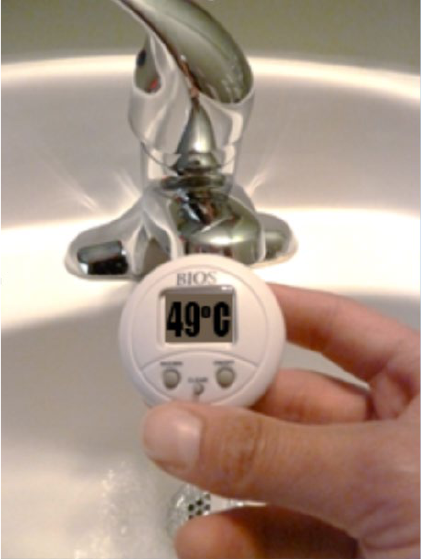
Health & Safety Guide for Operators of Child Care Facilities
7
Safe Healthy Environments - Environmental Public Health – May 2024
• Toys with smooth, easily cleanable surfaces (e.g., plastic toys) can also be
cleaned in a dishwashing machine. The dishwasher needs to be a commercial
model or a domestic model with a sanitizing cycle that has been tested by a PHI.
Water Temperatures
• Each facility must be capable of supplying adequate hot and cold water.
• The hot water heater should be able to heat and store water at a minimum of
60°C.
• For plumbing fixtures that children have
access to, the maximum hot water
temperature should be set at 49°C
(120°F) or less. This includes hand
washing sinks, bath faucets, and
showerheads.
• A tempering device blends water from
the hot and cold water lines at the
plumbing fixture so that the fixture
provides water at a pre-set temperature.
To prevent scalding, if a child or client
has access to a fixture, and that fixture
supplies hot water, an approved
tempering device is recommended.
• In areas where children are not allowed,
such as the kitchen or laundry areas, the
hot water temperature maximums do not
apply.
Sewage System
• Every child care facility shall be connected to the public sewage system, or to an
operational private sewage disposal system.
• The plumbing system and the sewage disposal system must be installed
correctly and maintained in a good operating condition. This includes the drains,
fixtures, traps, vents, stacks, waste disposal facilities, pump-out sewage holding
tanks, septic tanks and disposal fields.
Health & Safety Guide for Operators of Child Care Facilities
8
Safe Healthy Environments - Environmental Public Health – May 2024
Washrooms
• For child safety, you must be able to open all washroom door locks from the
outside.
• Ventilate all rooms containing a flush toilet, a bathtub or a shower. You can either
use a window to the outside or install mechanical fan ventilation.
• Washrooms need to be located where children can easily access them.
• Washrooms have to be appropriate for the age, size, and ability of the children in
care.
• If the washroom is not designed for children and modifications or equipment are
added, such as steps, stools and training seats, the equipment must be sturdy,
durable and easily cleaned. Steps and stools must be slip resistant.
• Every child care facility must have approved plumbing fixtures. This means at
least a flush toilet, a dedicated hand wash sink, and a bathtub or shower to bathe
children.
- There must be potable, hot
and cold running water at
the hand wash sinks,
bathtubs or showers.
- The hand wash sink must
be in the same room as
the flush toilet or close by.
- All washrooms need toilet
paper, soap, and a safe
way to dry hands (paper
towel, hot air dryer, etc.).
- If paper towels are used,
they must be kept in a
dispenser.
- Every washroom must
have a proper garbage
container lined with a
plastic bag.
- If cloth diapers are used, a
toilet must be next to every
diaper change area.
• Children in public accommodations such as a group home, with more than one
bedroom, may share a flush toilet, hand wash sink, and a bathtub or shower if:
- The children have access to the washroom without going through another
bedroom or outside of the building;
- The washroom is located on the same floor as, or on the next storey up or
down from the floor on which the bedroom is located; and
- Each toilet, washbasin, bathtub or shower doesn’t serve more than eight
people.
Heating & Indoor Air Quality
• Keep all rooms within the facility at a temperature of 20°C or greater.
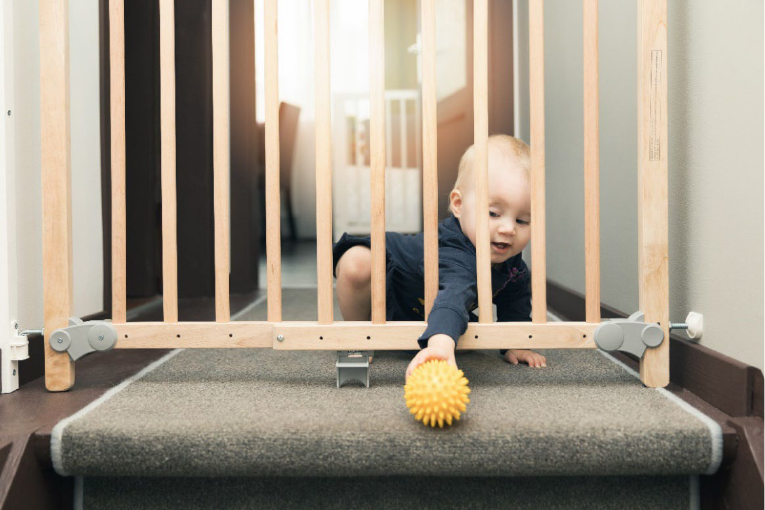
Health & Safety Guide for Operators of Child Care Facilities
9
Safe Healthy Environments - Environmental Public Health – May 2024
• Carbon monoxide alarms are strongly recommended if there is overnight
sleeping and the building contains a fuel-burning appliance or an attached
garage.
• If there are combustion engines outside, make sure they are kept away from the
building’s air intakes and take action to discourage idling.
• Provide enough air ventilation for good indoor air quality. Talk to your Public
Health Inspector about improving indoor air quality in your facility.
Stairways & Walkways
• If infants and toddlers have access to a stairway, install an appropriate and
secure gate at the stairway top and bottom.
• Stairways must have appropriate spacing and secure handrails and guards.
• Maintain all stairways, handrails, guards, and gates in good condition to
reasonably prevent injury. They must be kept safe and secure.
• Stairways and walkways must have enough lighting to see safely.
• Keep stairway and walkways free of snow, ice and other hazards.
• Infant crawling areas must be separate from general walkways and areas used
by older children.
ronstik/shutterstock.com
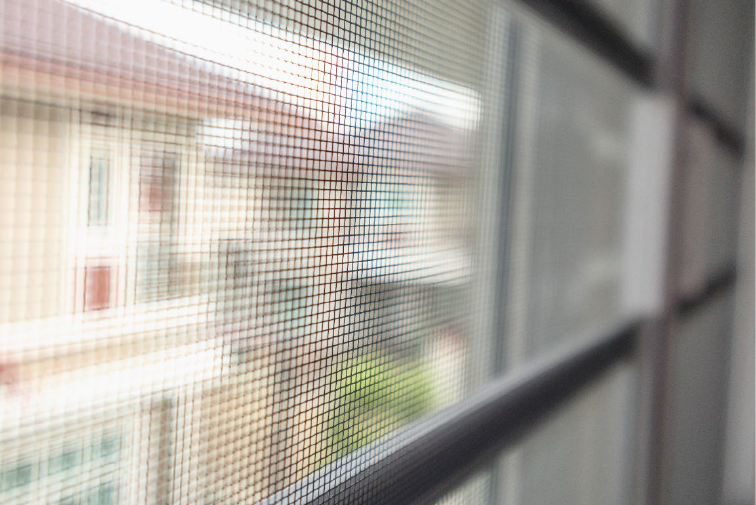
Health & Safety Guide for Operators of Child Care Facilities
10
Safe Healthy Environments - Environmental Public Health – May 2024
Kwangmoozaa/Shutterstock.com
Windows and Doors
• Keep out insects, mice, and other pests by installing screens on doorways, windows
and other openings used to provide ventilation.
• In daycare and pre-school facilities, use safety grade glass on glass mirrors or
windows that are installed within 1 metre from the floor.
• In group homes, day homes, and other facilities that provide accommodation, rooms
for sleeping must have a door or window that opens to the exterior of the building.
B
edroom egress windows or doors allow people to escape from the room if there is a
fire.
i. Rooms used for sleeping must have a window with an area that is at least 0.35
m
2
(3.8 ft
2
). The length and the width of the window cannot be less than 38 cm
(15”).
ii. If window security bars are installed, they must have a quick release device. If
there is no quick release, the security bars must be able to be opened without
tools or special knowledge.
iii. If a room used for sleeping doesn’t have a window or door to the exterior, contact
your PHI. For example, a group home may be approved to install a sprinkler
system. Otherwise, you can’t use this space as a room for sleeping.
iv. These requirements may not apply to facilities that do not provide
accommodation, such as daycares.
v. In the case of overnight care in licensed facility-based programs, ensure you
follow childcare licensing requirements.
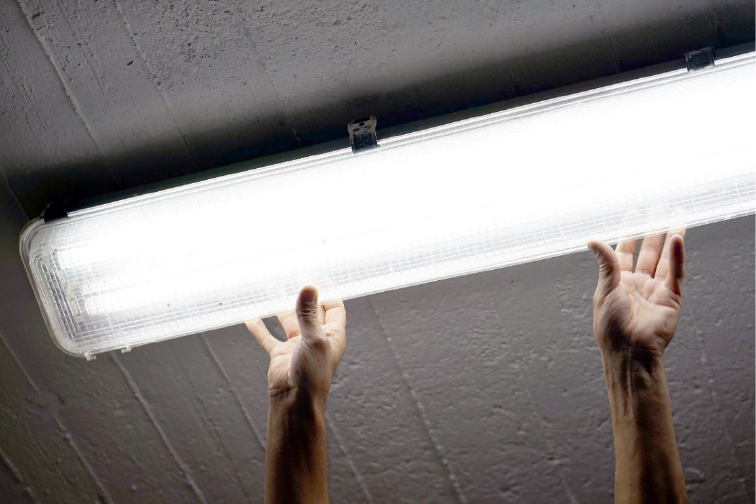
Health & Safety Guide for Operators of Child Care Facilities
11
Safe Healthy Environments - Environmental Public Health – May 2024
• Take precautions to prevent children from falling out of windows. If the window is not
required for emergency egress, fix the window so that it does not open more than 9
cm (3.5 inches) to prevent children from climbing through and falling out.
lunopark/shutterstock.com
Lighting
• Rooms used for sleeping need window coverings so the room can be made dark.
• Make sure all parts of the child care facility and surrounding property, including
outdoor play areas have enough light to be properly cleaned, maintained and
safe.
• The location for lighting, type of light used, and light covers should prevent glass
from broken light bulbs causing contamination of food or injury to clients.
Designated Areas
• Child care facilities should have adequate space and facilities for all activities
connected with the operation.
• There should be controlled access to all mechanical equipment rooms, storage
rooms, janitorial closets and maintenance shops, used in or around a child care
facility.
• Food preparation areas must be properly separated from other areas of the child
care facility. Children are not allowed in the food preparation areas, except for
supervised activities
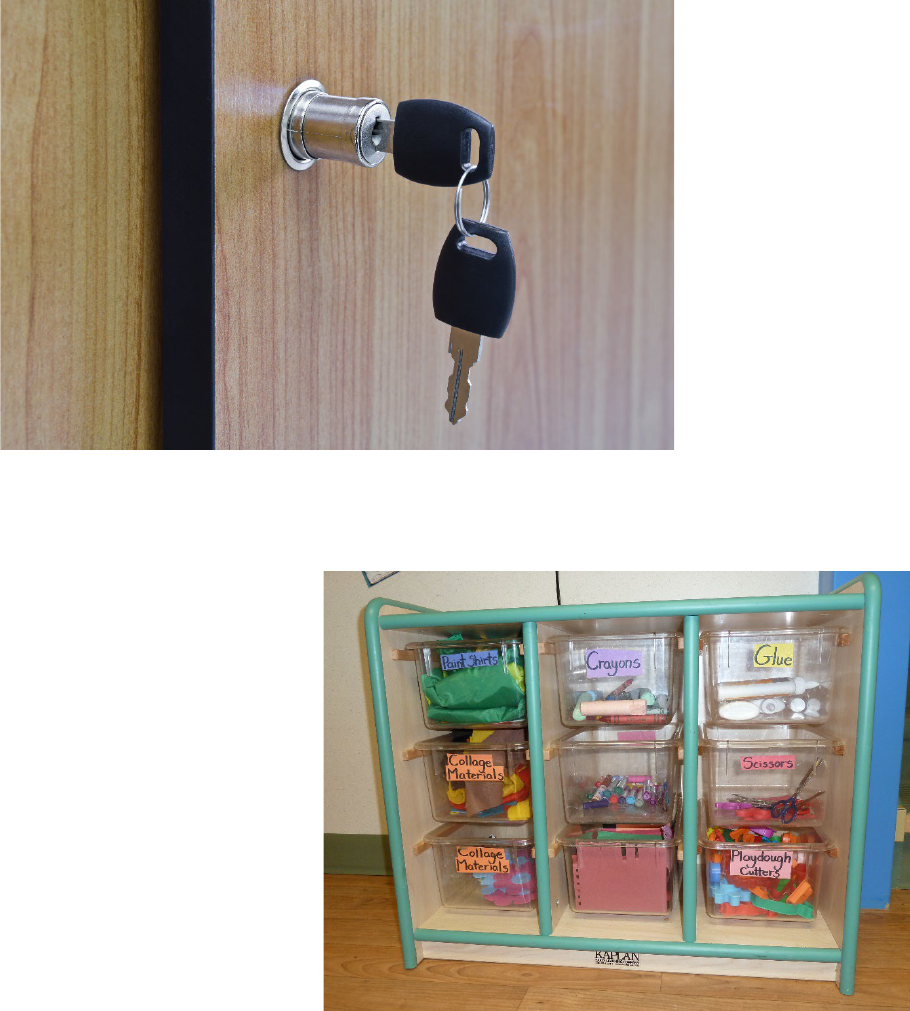
Health & Safety Guide for Operators of Child Care Facilities
12
Safe Healthy Environments - Environmental Public Health – May 2024
Storage Space
• Ensure there is enough space to store all equipment and materials used in the
child care facility.
• Store different types of items separately from each other. For example, store
cleaning products in a locked cabinet that is separate from food items.
Matee Nuserm/Shutterstock.com
• Have separate spaces for:
• foods and utensils
•
client and staff
personal items
•
unused/seasonal
items
•
laundry equipment
and supplies
•
cleaning equipment,
cleaning supplies and
any toxic materials
Health & Safety Guide for Operators of Child Care Facilities
13
Safe Healthy Environments - Environmental Public Health – May 2024
Sleeping
• Rooms or areas that are used for overnight sleeping need sufficient space:
• An area of at least 2.5 square metres per child under the age of 10.
• An area of at least 5 square metres for each person over the age of 10.
Sick Child Area
• Choose a supervised area to separate a child that is ill from the rest of the
children. This space must be:
• separate from any food areas
• well ventilated and heated
• large enough for a bed/mat
• easy to clean and disinfect
• 2 metres away from other children or staff not caring for child.
• Personal protective equipment (gloves, mask, eye protection and
gown/protective clothing) is recommended to be available to staff in this area.
Laundry Area
• Keep laundry areas separate from food areas.
• Laundry room floors, walls, and ceilings have to be smooth, non-absorbing and
easy to clean.
• Use proper venting to the outside of the building for exhausting the clothes dryer.
• You need enough space and proper containers to keep dirty laundry from
contaminating clean laundry.
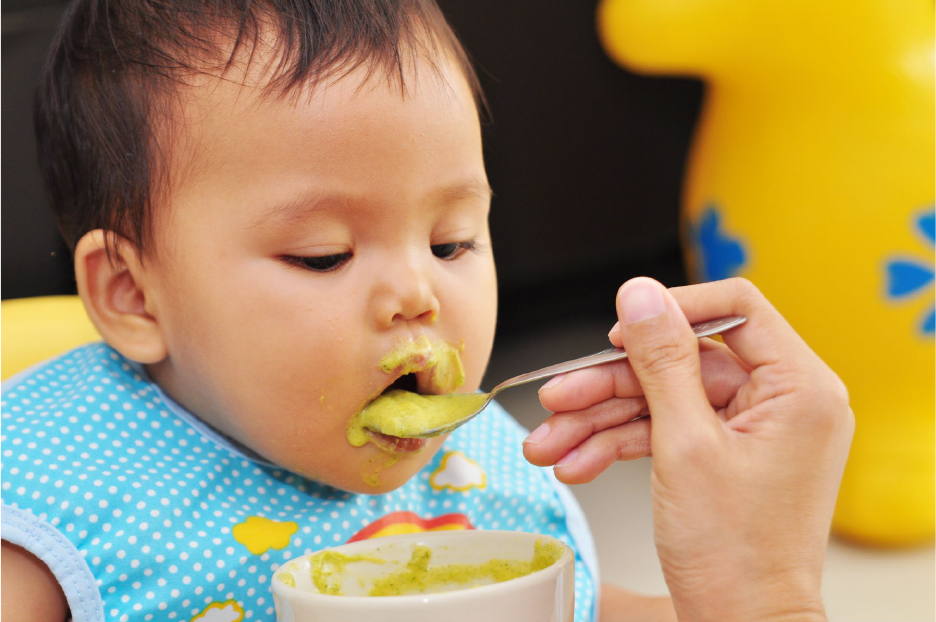
Health & Safety Guide for Operators of Child Care Facilities
14
Safe Healthy Environments - Environmental Public Health – May 2024
sixninepixels/shutterstock.com
Operational Requirements
Food Handling
• If your facility provides care to more than 10 children you are required to have a
food handling permit from AHS.
• If you provide care to 10 or less children, refer to the minimum food handling
standards in Appendix A.
• All foods served at a childcare facility and on field trips must be from an approved
source. An approved source means a permitted food facility that also gets
approval and inspections from AHS.
• Bag lunches and snacks may be provided by parents for their own children.
• For field trips, choose foods that are ready-to-eat. This means foods that don’t
need to be cooked or reheated before serving on the field trip. Packaged foods
should be kept in the package until children are ready to eat.
• Sometimes a parent may offer to bring or provide food for other children of the
facility (e.g., for a birthday). Contact the PHI to check what types of food are ok
for a parent to share. You also need to inform all the other parents if food from
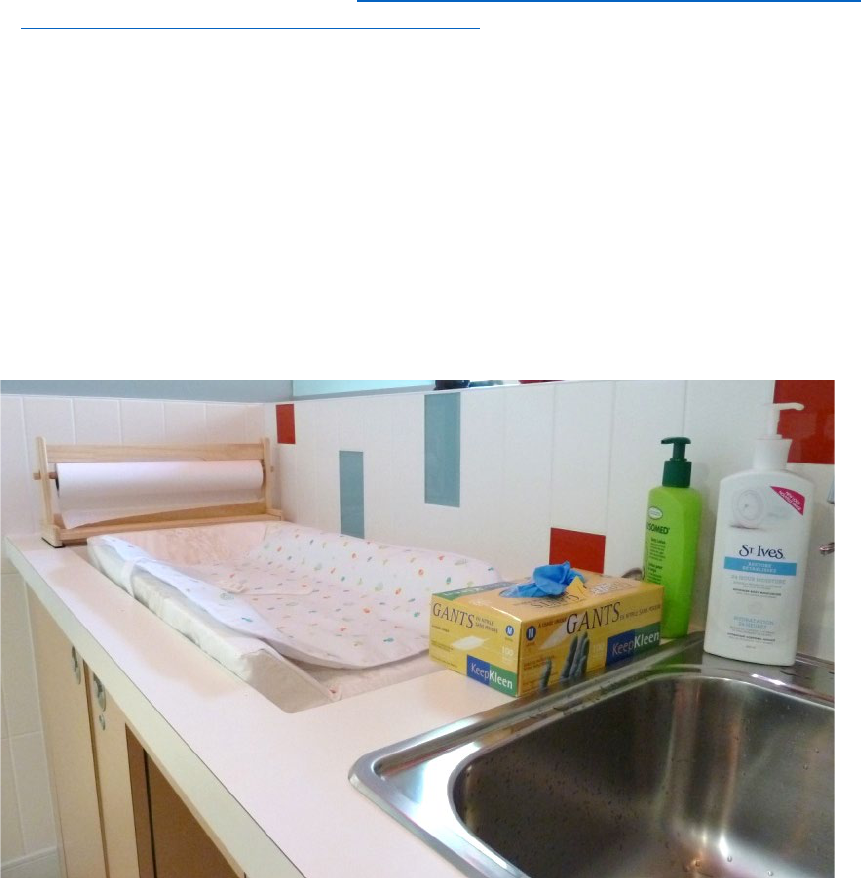
Health & Safety Guide for Operators of Child Care Facilities
15
Safe Healthy Environments - Environmental Public Health – May 2024
outside the child care facility is being served. Generally, food provided for other
children by parents must be:
i. Non-perishable foods. Hard cheeses, fruits, and vegetables are also
acceptable, but they must be transported at 4°C or colder.
ii. If the food is perishable (See Appendix A for an explanation of perishable
foods) :
a. keep below 4°C or above 60°C; and
b. It must have been prepared in a food establishment that has a food
handling permit from AHS. The food needs to be provided to the
child care facility in the original container.
• “Family-style meal service” is where food is placed in large serving dishes on the
table, allowing children to serve themselves. For more information about how to
practice this safely, please visit https://www.albertahealthservices.ca/assets/wf/
eph/wf-eph-family-style-meal-child-care.pdf.
Diapering
• Diaper changing areas and storage of dirty diapers must be kept completely
separate from areas where food is prepared. This includes areas where a
microwave is used for reheating foods and areas where sinks are used to fill
and/or mix bottles.
• Each diapering station needs to be located next to a designated hand washing
sink with hot and cold running water, soap and paper towels.
Health & Safety Guide for Operators of Child Care Facilities
16
Safe Healthy Environments - Environmental Public Health – May 2024
• The diapering surface must be made of a non-absorbent material that can be
cleaned and disinfected after each use.
• The diapering surface cannot be used for any other activity.
• Use safety belts or other approved devices to restrain children on elevated
diapering surfaces.
• Never leave children unattended on a diapering surface.
• Follow the approved diapering procedure in Appendix B.
• Thoroughly clean and disinfect the diapering surface after each use.
• For each child, place a fresh diapering surface to cover the changing area (e.g.,
new paper for each child).
• At least once a day, clean and disinfect containers used for soiled diapers
Personal Hygiene
• Staff must be free from open infected sores or wounds, wear clean clothing, and
must not smoke in any area used by children.
• Staff and children need to properly wash their hands:
- before eating;
- before they do any food
service activities including
setting tables;
- after playing with sand and
water;
- after playing outdoors;
- after using the toilet or diaper
changes;
- after playing with animals;
- after any activity which
leaves hands dirty or
contaminated.
• Using hand sanitizer:
- Do not use hand sanitizers instead of handwashing.
- Hand sanitizers do not work if hands are dirty.
- Hand sanitizers are NOT acceptable during diapering or food preparation.
- Hand sanitizers are not appropriate for infants and toddlers.
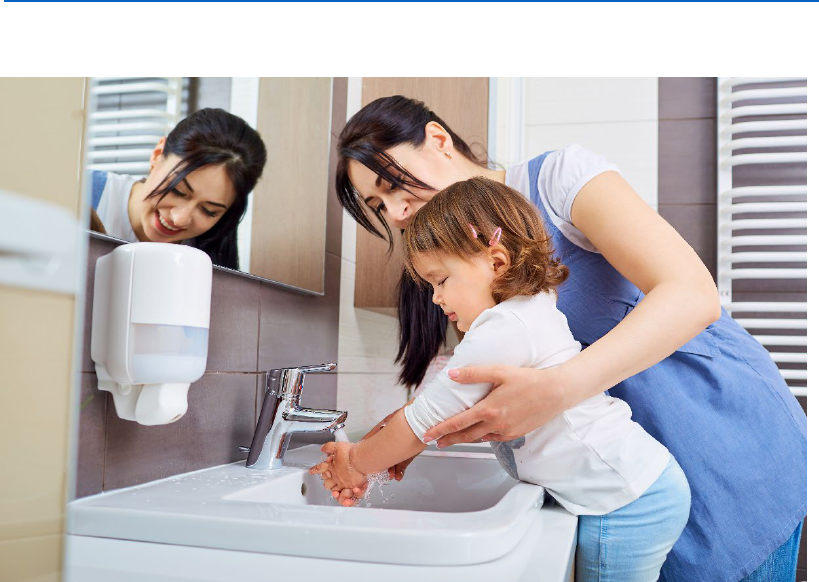
Health & Safety Guide for Operators of Child Care Facilities
17
Safe Healthy Environments - Environmental Public Health – May 2024
• Proper hand washing means:
1. Wet hands with warm water.
2. Put soap onto the hands.
3. Rub soapy hands together for at least 20 seconds. Use the time to wash the
front and back of hands, up past the wrists, the thumbs, fingers and finger
tips.
4. Special attention should be given to areas underneath fingernails, between
fingers and wrists.
5. Rinse the soap off with clean, warm, running water.
6. Dry hands and arms thoroughly, using paper towels. Hot air dryers are
allowed but discouraged.
7. If cloth towels are used, they can only be used once, then moved to dirty
laundry. Individual cloth towels can be reused and changed daily.
8. After handwashing, touching the sink or bathroom door handle will
recontaminate your hands. Use a towel to turn off the taps or open the door.
• For hand washing posters suitable for children, visit
https://www.albertahealthservices.ca/assets/wf/eph/wf-eh-youd-clean-em.pdf
Studio romantic/Shutterstock.com
Health & Safety Guide for Operators of Child Care Facilities
18
Safe Healthy Environments - Environmental Public Health – May 2024
Preventing the Spread of Communicable Disease
• Programs should keep records of children’s known pre-existing conditions
(allergies, etc).
• Staff should assess children for signs of a contagious illness, and should monitor
children for the following symptoms:
o Fever
o Cough
o Shortness of breath
o Runny nose
o Sore throat
o Chills
o Painful swallowing
o Nasal congestion
o Feeling unwell / fatigued
o Nausea / vomiting /
diarrhea
o Unexplained loss of
appetite
o Loss of sense of taste or
smell
o Muscle / joint aches
o Headache
o Conjunctivitis (commonly
known as pink eye)
• Staff cannot be at the child care facility with symptoms of a contagious illness,
such as rash, sore throat, fever, sneezing, coughing, runny nose, stomach
cramps, vomiting or diarrhea.
• If AHS has excluded a child or staff person from the child care facility because
they have a contagious illness, that child or staff person is not allowed in the child
care facility. You’ll be working with your local PHI, or another AHS staff member,
to confirm when the affected staff person or child is free of contagious illness and
when they can safely return to the facility.
• Label all children’s personal items: bottles, combs, brushes, toothpaste,
toothbrushes, clothing and pacifiers. Personal items need to be stored and
handled in a safe and sanitary manner at all times, and should not be shared
between children. Bottles need to be properly cleaned and sanitized between
uses.
Objects that become contaminated by body fluids such as saliva, mucus, feces,
vomit, or other discharge, must be stored in a separate, labeled container
intended for cleaning and disinfection.
Health & Safety Guide for Operators of Child Care Facilities
19
Safe Healthy Environments - Environmental Public Health – May 2024
Communicable Disease Outbreak Management
• If the number of children and/or staff that have become sick with similar
symptoms is more than usual, the facility may be having an outbreak.
• During an outbreak, the facility has to operate differently than usual, to prevent
the illness from spreading to many people. Additional precautions can include:
o Increased cleaning and disinfection (see Appendix C).
o Removing shared toys and activities where enhanced cleaning and
disinfection cannot be done (eg. Water table, sand table).
o Diligent hand hygiene practices.
o PPE usage among staff.
o Limiting parents from entering classrooms during pick-ups/drop-offs.
o Limited mixing or gathering of children with the affected classroom. This
may require you to cohort children/staff, cancel field trips, restrict the use
of common spaces, and to pay extra attention to cleaning and disinfecting
of common spaces.
o Postponing or restricting non-essential visits to the centre.
• If you suspect there is a possible outbreak of illness at your facility, you are
required to report the details to AHS and follow AHS guidelines to manage the
illnesses.
• To prevent outbreaks, the sick child should be isolated in a separate room and
the parent or guardian should be notified to come and pick up the child
immediately. If a separate room is not available, the child needs to be kept at
least 2 metres away from other children and staff not caring for the sick child.
• If the child is young and requires close contact and care, staff can continue to
care for the child until the parent is able to pick-up the child. Staff should wear a
mask and eye protection during all interactions with the child and should avoid
contact with the child’s respiratory secretions.
• Collect details and manage illnesses in children and staff at the facility. Your local
PHI can provide directions and may have a template to help you keep track of
illness information.
• During outbreaks of illness, disinfectant concentrations need to be increased. Go
to Appendix C to see what disinfection procedures to follow during an outbreak.
o Shared spaces, structures and toys that cannot be cleaned and
disinfected between cohorts should not be used.
o If play structures are to be used by more than one group, consider limiting
use of the structures and enhanced cleaning of shared equipment.
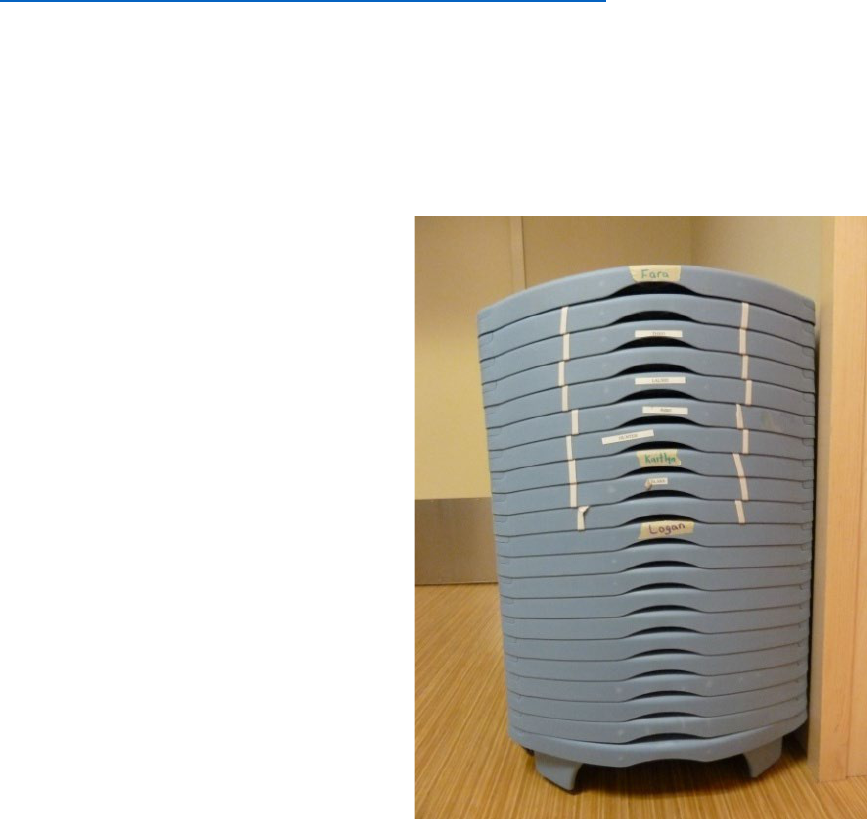
Health & Safety Guide for Operators of Child Care Facilities
20
Safe Healthy Environments - Environmental Public Health – May 2024
o All items, such as bedding, toys etc., used by the child in the 48 hours
prior to the onset of their symptoms and while isolated should be cleaned
and disinfected as soon as the child has been picked up. Items that
cannot be cleaned and disinfected (e.g. paper, books, cardboard puzzles)
should be removed from the centre and stored in a sealed container for a
minimum of 24 hours.
o Do not store client/staff’s personal items in common spaces, such as
washrooms.
o Programs that utilize a space that has other after-hours user groups (e.g.
programs in churches, community centres) should ensure the space is
cleaned before and after using the space. It is recommended that cleaning
be done by one person within the cohort directly before the group enters
the space and after it exits the space. A cleaning log should be posted and
used to track cleaning
• For more information on cleaning and disinfection during an outbreak, visit
https://www.albertahealthservices.ca/info/page6421.aspx. You can also contact
your local PHI or AHS Communicable Disease Control.
Sleeping
• Beds need to be made of a material that is easy to keep safe, clean and sanitary.
• Handle and store bed linens, so they stay clean, dry and sanitary. Bed linens that
have been used by a child have to
be cleaned in the washing machine
before they can be used for another
child.
• When bedding becomes soiled,
including blankets, wash and then
dry in a hot dryer. Moisture-resistant
covers of plastic or rubber can be
washed and disinfected.
• Clean the bed sheets that are being
used in the washing machine at
least once per week.
• It is best to wash bed linens onsite
or at a commercial facility. Bedbugs,
lice and other pests might have a
chance to spread if linens are
washed in personal homes.
• Store each child’s bed linens
separate from each other, so that

Health & Safety Guide for Operators of Child Care Facilities
21
Safe Healthy Environments - Environmental Public Health – May 2024
they don’t touch, and are protected from getting contaminated.
• Label bed linens with the name of the child that will be sleeping on them.
• Sleeping areas need to be large enough to have 60 cm of open space on all
sides of beds except where the bed is next to a wall.
• When children are placed side-by-side for sleeping, arrange them so that the
head of one child is next to the feet of the next child, and so on. This will help to
avoid children coughing in each other’s faces while sleeping.
• The space you use for napping can also be used for a play area.
• See Appendix D for requirements for cribs.
• Double-sized beds and bunk beds are not allowed in a child care facility.
• Family shelters can use bunk beds, but safety guards should be installed on
upper bunks to prevent a child from falling out.
Play Equipment
• All toys and play materials must be
durable, easy to clean and safe to
use.
• Clean and disinfect all toys and play
materials using the schedule in
Appendix F.
• Use craft materials and supplies that
you know are non-toxic and safe.
• Craft materials should be appropriate
for the age of the children using
them. See Appendix E for more
safety information on arts and crafts.
• Toys that infants and toddlers put in
their mouth must be cleaned and
disinfected between uses (after each
child)and at least once a day.
• Don’t let children share stuffed toys
unless the toys can be properly
cleaned in a washing machine and
then put through a hot dryer cycle.
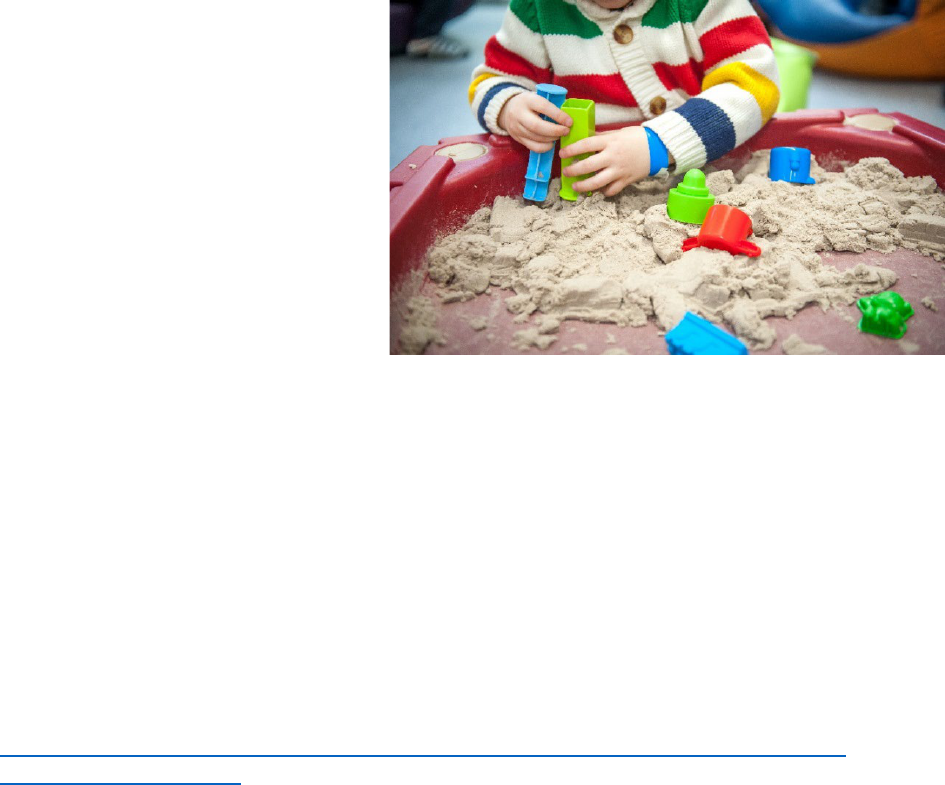
Health & Safety Guide for Operators of Child Care Facilities
22
Safe Healthy Environments - Environmental Public Health – May 2024
• Trampolines, rebounders, and similar equipment are NOT ALLOWED in a child
care facility. They are not allowed to be part of the child care facility’s activities.
• Water play tables must be kept clean, free from debris, and in good condition at
all times. They have to be emptied, cleaned, and disinfected between each group
of children or at least twice a day (once in the morning and once in the
afternoon).
• Play table covers if provided, must be smooth, impervious to moisture, and easily
cleaned.
• Keep sand tables, sand boxes
and the play sand clean, free
from clay, silt, dirt and other
contaminants. Only use approved
play sand.
• Ideally, indoor play sand is
replaced at least every two years.
If the sand becomes
contaminated sooner, you must
empty, clean and sanitize the
container and replace the sand.
Disinfecting sand is not
recommended. Throw away the
old or contaminated sand.
• Outdoors, sand boxes should have proper drainage and need a proper cover that
prevents access to animals.
• The sand in outdoor play areas needs to be turned over at least once a year. Dig
up and mix the sand to a depth of at least 46 cm or 18 inches.
• Sand that falls out of the table or box shall be discarded.
Some child care programs want to use natural materials and loose parts for play
(e.g. pinecones, sticks, leaves, cardboard, paper towel rolls, nuts, and bolts). If
these materials are not from a safe source, or are used incorrectly, they may
become a hazard. For recommendations on how to choose, maintain and safely
handle natural materials and loose parts, please visit
https://www.albertahealthservices.ca/assets/wf/eph/wf-eph-recommend-natural-
materials-childcare.pdf.
Sharomka/shutterstock.com
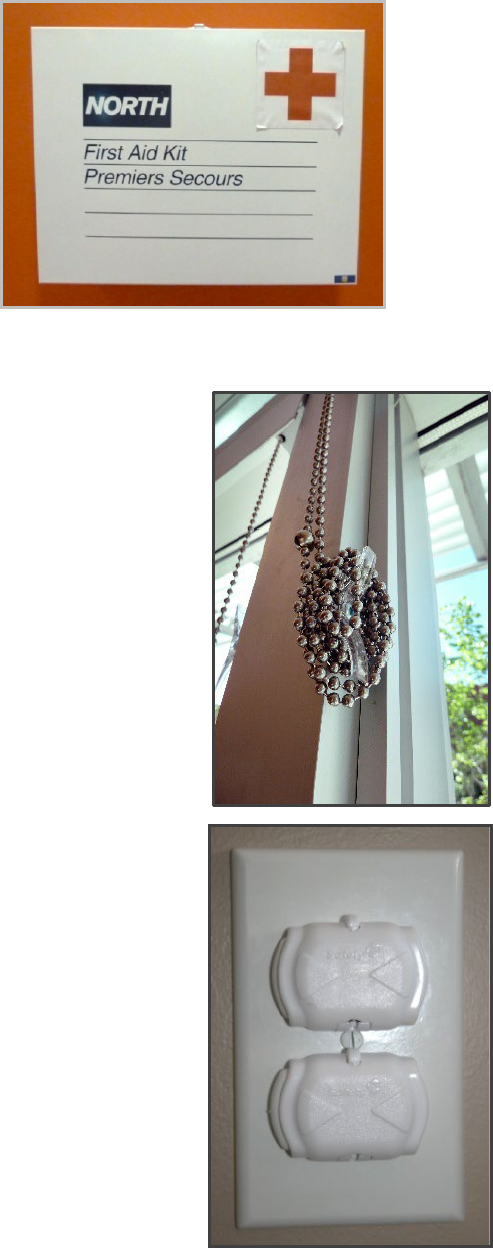
Health & Safety Guide for Operators of Child Care Facilities
23
Safe Healthy Environments - Environmental Public Health – May 2024
First Aid
• The child care facility must have first aid
kits that are ready to use and available,
both at the facility and on field trips.
• Please see Appendix H for information
about what materials are required in first
aid kits for your child care facility. This is
based on Occupational Health and Safety
Code, AR 191/2021 which consider:
o Child care is considered a medium
hazard work
o Number of workers in the child care facility
o Distance from the child care facility to a hospital
or to 24-hour medical care.
Equipment & Safety
• Be careful to protect children from radiators or other heating
devices, hot water pipes, electrical outlets, poisonous plants,
window blind cords, and other hazards.
• Make sure furniture is stable and not easily tipped over.
• Use proper anchors to attach tall or heavy furniture such as
book shelves and dressers to the wall. This will prevent furniture
from falling over onto children.
• Make sure high chairs have safety belts.
• The high chairs must be stable and kept in good condition.
• The high chair feeding trays must be smooth and easy to
clean.
• Make sure children cannot access any mechanical equipment
rooms, storage rooms or janitor closets.
• If a serious injury occurs in your child care facility, you should
report it to your local public health inspector.
Maintenance & Cleaning
• See Appendix G for how often the child care facility needs to
be cleaned and disinfected.
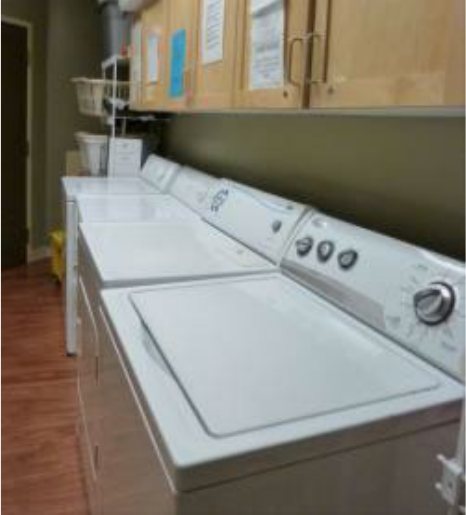
Health & Safety Guide for Operators of Child Care Facilities
24
Safe Healthy Environments - Environmental Public Health – May 2024
• See Appendix I for required steps to clean and disinfect where there is blood,
feces, vomit, or other body fluid spills.
• You can create and use checklists to help ensure staff are completing regular
maintenance of the child care facility. For example, checking and maintaining
facility equipment and playground equipment on a regular schedule.
Laundering
• See Appendix G for how often to
wash bed sheets, towels, bibs,
play clothes, plush toys and
other cloth items.
• If cloth items become
contaminated with blood, vomit,
feces, lice or scabies, they have
to be stored, transported,
laundered separately from other
laundry. After contaminated
items are washed, they have to
be hot air dried.
• Keep clean and dirty laundry
separated. The containers you
use for clean laundry cannot be
used to store or carry dirty
laundry.
Garbage
• Use proper garbage, recycling and other containers made of plastic or metal.
Garbage and organics containers must be watertight with a tight-fitting cover.
• Remove garbage and recycling from the child care facility as often as needed to
prevent the material from piling up. Garbage and recyclables should not be
spilling out of bins, dumpsters or other storage containers.

Health & Safety Guide for Operators of Child Care Facilities
25
Safe Healthy Environments - Environmental Public Health – May 2024
Biomedical Waste
• If needles and other sharps are used in
the child care facility, they must be
disposed of in puncture-resistant sharps
containers (see picture).
• Keep sharps containers available
wherever the sharps are used and in a
location inaccessible to children.
• When sharps containers are ¾ full or
filled to the fill line, stop adding any more
sharps and dispose of the container.
Seal the full sharps container, then
secure and discard it safely.
• Sharps cannot be sticking out of the
sharps container.
Animal Care and Control
• Some animals are not
allowed in childcare facilities.
Child care facilities are NOT
allowed to keep certain types
of turtles. These are usually
freshwater turtles that have
been known to cause
outbreaks of illness, such as
infections with Salmonella.
Here are the common names
(followed by Genus name) of
turtles that are not allowed in
a child care facility:
- “Cooter” turtles (Pseudemys)
- “Map”or “Sawback” turtles (Graptemys)
- “Painted” turtles (Chrysemys)
- “Snapping” turtles (Chelydra)
Sergii Votit/shutterstock.com

Health & Safety Guide for Operators of Child Care Facilities
26
Safe Healthy Environments - Environmental Public Health – May 2024
• Some animals require written
approval from the PHI. These
include cats and dogs, birds of all
varieties (including poultry, e.g.
chicks), chinchillas, ferrets,
hedgehogs and other animals known
to bite, and reptiles and amphibians.
• Your local PHI needs to be notified
before most animals can be kept in
the child care facility. Although
animals such as gerbils, hamsters,
guinea pigs and rabbits do not
require written approval, you still
need to let the PHI know if you plan
to have these animals in your child
care facility. The PHI will want to
discuss plans for keeping the animal
and animal handling.
• Notification is also needed for
animals that are visiting as part of a
special event or for
entertainment/education activities.
• You do not need to notify the PHI if you want to keep fish or ant farms.
• These requirements for animals do not apply to qualified service animals (e.g.,
service dog for a client with a disability).
• The PHI may require that the child care facility provide a report from a veterinarian,
indicating that an animal is healthy, disease-free and has proper vaccinations.
• Do not allow animals in food preparation or food storage areas.
• Keep animal supplies (food, cleaning equipment, etc.) completely separate from
foods for the child care facility.
• The animal must have a proper cage, or other proper container appropriate for the
animal (e.g., fish bowl).
• When an animal is taken out of its cage, the animal has to be kept under control and
supervised, to prevent child injury or contamination of the child care facility.
• Handwashing is very important after handling an animal. Employees and children
must wash their hands immediately after touching an animal, animal waste, or any
animal-related supplies.
• Report animal bites to Public Health.
• For more detailed information on animals in child care facilities and for
application forms for keeping animals, visit
https://www.albertahealthservices.ca/assets/wf/eph/wf-eh-application-info-
animals-scf.pdf.
AlexKalashnikov/shutterstock.com
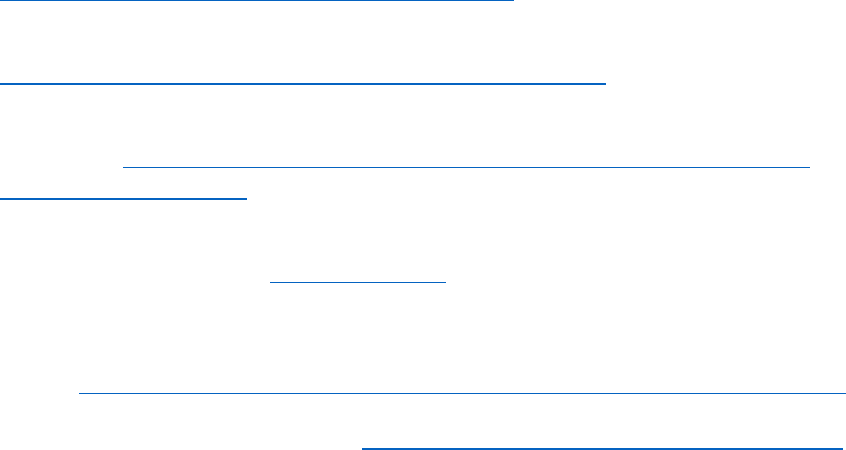
Health & Safety Guide for Operators of Child Care Facilities
27
Safe Healthy Environments - Environmental Public Health – May 2024
Resources
1. Public Health Act and Regulations, Alberta King’s Printer website:
https://www.alberta.ca/alberta-kings-printer.aspx
2. Alberta Health Services Outbreak Management Support Material
https://www.albertahealthservices.ca/info/page6421.aspx
3. First Aid Requirements and First Aid Kits, Alberta Occupational Health and
Safety Act: https://www.alberta.ca/occupational-health-and-safety-code-and-
explanation-guide.aspx
4. Environmental Public Health Online Resources and Training Courses, Alberta
Health Services website: www.ahs.ca/eph - click on Information for your
Business or Community or Education Courses
5. Drug Identification Number, Health Canada’s Drug Product Database Online
Query: http://www.hc-sc.gc.ca/dhp-mps/prodpharma/databasdon/index-eng.php
6. Healthy Parents Healthy Children https://www.healthyparentshealthychildren.ca
Health & Safety Guide for Operators of Child Care Facilities
28
Safe Healthy Environments - Environmental Public Health – May 2024
Appendix A - Food Safety Recommendations for Child Care Facilities with
10 or Less Children
Food Source
• All food must come from an approved, inspected source. Home-canned foods are
not allowed except fruit jams, jellies and pickles.
Food Protection
• Foods must be protected from dirt, dust, pests, broken glass, sneezes, and other
contaminants.
• Food storage must be clean and sanitary.
• Surfaces that are used to prepare or process foods must be smooth, non-absorbent,
and easy to clean.
• You cannot store food or food service items in a washroom.
• Keep foods separated from any chemicals, medicine, or other poisonous substances.
• Packaging material that touches food must be clean and sanitary.
Temperature Control
• All perishable foods must be kept below 4
o
C or above 60
o
C. Perishable foods are foods
that contain:
- Meat and poultry
- Fish and seafood
- Eggs
- Milk and other dairy such as
cheese and butter
- Cooked cereals (e.g. rice)
- Cooked vegetables
- Any fruit or vegetable that has
been cut or peeled
Equipment
• Thermometers are required for monitoring temperatures of foods, refrigerators, and the
hot water supply.
• If there is no dishwashing machine, a sink with two compartments is required.
• If you have a dishwashing machine, a single sink is still required.
• A hand washing sink with soap and single-use towels should be located in all food
preparation areas.
• Use the longest and hottest wash and dry cycle settings on domestic dishwashing
machines.
• If washing dishes by hand, the proper dishwashing procedure should be followed as
outlined in the figure below.

Health & Safety Guide for Operators of Child Care Facilities
29
Safe Healthy Environments - Environmental Public Health – May 2024
Sanitation
• An approved sanitizer should be available on site. These include:
- Chlorine bleach at a concentration of 100 ppm (parts per million). To make up a
100 ppm solution using household bleach: mix ½ teaspoon of bleach into 1 liter
of water.
- Quaternary Ammonium Compounds (known as Quats) at a concentration of
200 ppm. To make up a 200 ppm solution, follow the manufacturer’s
instructions.
- Iodine at a concentration of 12.5-25 ppm. To make up a 12.5-25 ppm solution,
follow the manufacturer’s instructions.
• Accelerated Hydrogen Peroxide. Follow the manufacturer’s instructions for food
contact surfaces.
• Use test strips to make sure that mixed sanitizer solutions remain at the correct
concentration over time. If test strips aren’t available, mix fresh sanitizer solutions daily.
Hygiene
• Food handlers must follow good personal hygiene habits.
• Food handlers must wash their hands before handling food, and ANYTIME their hands
become contaminated (e.g. after using the toilet, after handling raw meat, after
sneezing or coughing into hands, after handling garbage).
Training
• Basic food handling safety courses are recommended for all child care facilities.
• If there are 4 or more clients in the child care facility, one person must complete
a basic course in safe food handling consisting of 2-3 hours of instruction or
home study.
• You can complete a free, basic course, or register for a complete certification course by
visiting EPH’s website at https://www.albertahealthservices.ca/eph/Page3151.aspx
.

Health & Safety Guide for Operators of Child Care Facilities
30
Safe Healthy Environments - Environmental Public Health – May 2024
Appendix B – Diapering Procedure
1. Place clean paper liner on the changing surface.
2. Place the child onto the paper liner, and fasten the safety belt around the child. Never
leave a child unattended on a change table.
3. Remove and discard the dirty diaper.
4. Clean the child’s skin with a single-use towel, wiping from front to back. Single-use towel
could be a disposable type wipe or a cloth towel used once.
5. Use a single-use dispenser for any ointments or creams that you want to use.
6. Remove and throw away the paper liner.
7. Put a fresh diaper on the child, and dress the child.
8. Wash or wipe the child’s hands.
9. Remove the child from the change area.
10. Clean and disinfect the changing surface. If there is visible contamination, clean the
surface with detergent, then wipe detergent away, before you disinfect the changing
surface.
11. Wash all parts of your hands with soap and water.
Approved Disinfectant
How to Mix
Solution Strength
Chlorine Solution
Add 2 ml (1/2 teaspoon) household
bleach to a litre (4 cups) of water.
100 mg/l (or ppm)
of Chlorine
Accelerated Hydrogen
Peroxide Solution
Follow manufacturer’s instructions
for mixing the correct dilution. The
product must have a DIN (Drug
Identification Number) issued by
Health Canada.
0.5% accelerated
hydrogen peroxide (with
disinfectant claim)
Disposable diapers: Put into a washable, durable garbage container that is lined with a
plastic bag. The container must have a tight fitting lid that is kept closed between uses.
Cloth diapers: Put the fecal contents from the diaper into a toilet. Put the diaper in a
washable, durable diaper pail with a tight fitting lid, or in a strong plastic bag to prevent
leakage. Keep containers or bags closed between uses. Remove the soiled cloth diapers in
their bags or pails for laundering at the end of each day. If parents provide the diapers, place
diapers into a covered container or sealed bag without rinsing.
If cloth towels are used for wiping, the towels must be immersed into an approved disinfectant,
such as the bleach solution above. Cloth towels should only be used once and then placed into
a covered container. Launder at the end of each day.

Health & Safety Guide for Operators of Child Care Facilities
31
Safe Healthy Environments - Environmental Public Health – May 2024
Appendix C - Surface Cleaning & Disinfection Guidelines for Outbreaks in
Child Care Facilities
A. Surfaces of Concern
“High touch” surfaces are the surfaces that are most likely to be contaminated, and should be
cleaned and disinfected multiple times and when visibly soiled.
Give extra attention to these surfaces:
• Tabletops,
• Light switches,
• Door knobs,
• Sink taps,
• Toilet handles,
• Other surfaces that are
frequently touched.
B. Procedures: “Wipe Twice”
For high touch surfaces that are not grossly contaminated, you can use a “wipe twice”
procedure to clean and then disinfect. Wipe the surface thoroughly to remove dirt and other
contamination, then disinfect by wiping the surface a second time with another clean cloth that
has been soaked with one of the disinfectants below.
If a high touch surface is very dirty, it should be first washed with soap, then the soap rinsed
away with a clean cloth, then the surface wiped with another clean cloth that has been soaked
with one of the disinfectants below.
C. Disinfectants
Disinfectants permitted by Environmental Public Health for use during outbreaks:
1. Diluted household bleach solution. Prepare fresh disinfectant solution every day.
Add 1/3 of a cup (20 ml) of 5% household bleach to 4 litres of water. This creates a
1:50 bleach dilution that provides the recommended 1000 ppm (or mg/L) chlorine
disinfectant.
OR
For gastrointestinal outbreaks a disinfectant with a Drug Identification Number (DIN)
issued by Health Canada with a specific label claim against norovirus, feline
calcivirus or murine norovirus. An example of a product with this label claim currently
in wide use is 0.5 accelerated hydrogen peroxide. There are other products with this
label claim.
• For respiratory outbreaks a disinfectant must have a Drug Identification Number
(DIN) and a broad-spectrum virucidal claim OR a virucidal claim against non-
enveloped viruses or coronaviruses. Consider products approved by Health
Canada.
Get more information on cleaning and disinfection during an outbreak, at
https://www.albertahealthservices.ca/info/page6421.aspx
. You can also contact your local PHI
or AHS Communicable Disease Control.
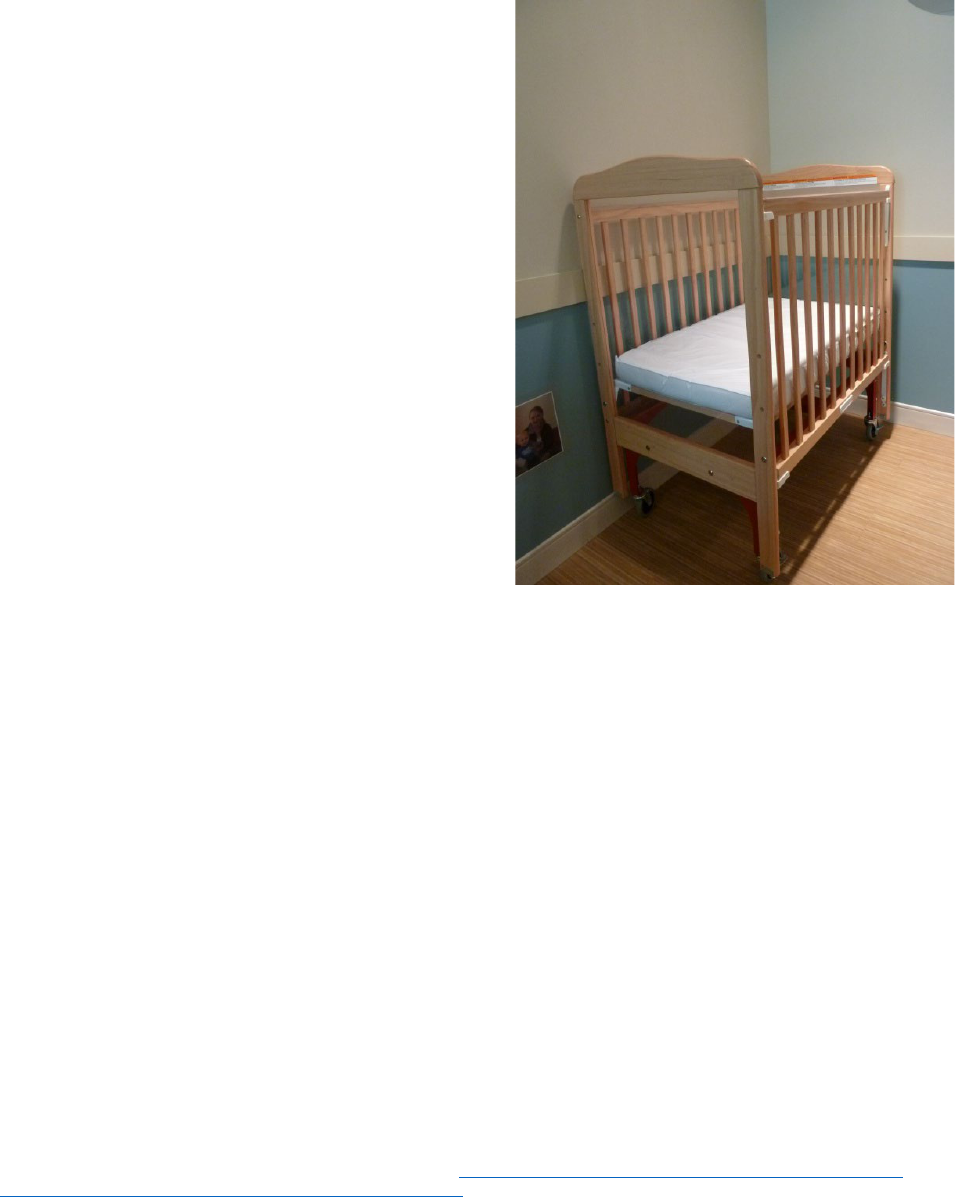
Health & Safety Guide for Operators of Child Care Facilities
32
Safe Healthy Environments - Environmental Public Health – May 2024
Appendix D – Crib Safety Checklist
□ Built after September 1986 and with a
product label that includes model
name/number and date of manufacture.
Pay special attention to cribs more than
10 years old for wear and tear,
including broken or loose parts.
□ Do not use crib if the baby is taller than
90cm or if the baby is able to climb out
□ Assembly instructions and parts list
attached.
□ No more than 3 cm (1.2 in) of space
between the mattress and the bed
frame when the mattress is pushed
flush to one corner of the crib.
□ Mattress no thicker than 15 cm (6 in)
and tight fitting against all four
sides of the crib.
□ Crib slats no more than 6 cm (2 3/8 in)
apart.
□ Crib sides have secure locking devices. Sides locked in highest position.
Traditional drop-side cribs are prohibited.
□ No dangling strings on crib gyms or mobiles. Baby should not be able to reach
mobiles.
□ No large toys, stuffed toys, objects or bumper pads in the crib.
□ The crib is not in front of a window or within reach of curtain or blinds cords,
lamps, electrical plugs, and extension cords.
□ Babies less than one year of age are always placed on their back to sleep.
□ Babies are moved to the crib if they fall asleep in a swing, infant seat, car seat or
stroller.
□ The crib has to be in good repair. Conduct routine/regular checks for:
tight bolts/ screws
no loose parts
wood smooth, metal free of
sharp edges
slats tight
mattress firm
Adapted from Is “Your Child Safe? Sleep Time”, Health Canada,
https://www.canada.ca/content/dam/hc-sc/migration/hc-sc/cps-
spc/alt_formats/pdf/pubs/cons/child-enfant/sleep-coucher-eng.pdf , 2012

Health & Safety Guide for Operators of Child Care Facilities
33
Safe Healthy Environments - Environmental Public Health – May 2024
Appendix E – Arts & Crafts Safety
Use only non-toxic arts and crafts materials. Look for the Approved Product Seal by the Art and
Creative Materials Institute. Products with the Cautionary Label Seal should not be used with
young children.
Approved product seal Cautionary product label seal
• Avoid eating or drinking during arts and crafts activities.
• Ensure children wash their hands after arts and crafts activities.
• Ensure arts and crafts materials are stored in a secure area, inaccessible to children.
AVOID
USE
Powdered clay. It is easily inhaled and contains
silica and possibly asbestos. Do not sand dry
clay pieces or engage in other dust-producing
activities.
Talc-free, premixed clay. After using
clay, wet mop or sponge surfaces
thoroughly.
Ceramic glazes or copper enamels. Water-based paints instead of glazes.
Adults may waterproof pieces with
shellac or varnish.
Cold-water, fibre reactive dyes or other chemical-
based commercial dyes.
Vegetable and play dyes (such as onion
skins, or tea) as well as food dyes.
Instant paper mâchés, which create inhalable
dust and may contain lead or asbestos.
Make paper mâché from black and white
newspapers and library or white paste.
Powdered tempera paints, which create inhalable
dust and may contain toxic pigments.
Liquid tempera paints or paints an adult
premixes.
Solvents such as turpentine, toluene, and rubber
cement thinner and solvent-containing materials.
Water-based products only.
Aerosol sprays. Water-based paints with brushes or
splatter techniques.
Pastels, chalks, or dry markers that create dust. Oil pastels, crayons, or dustless chalks.
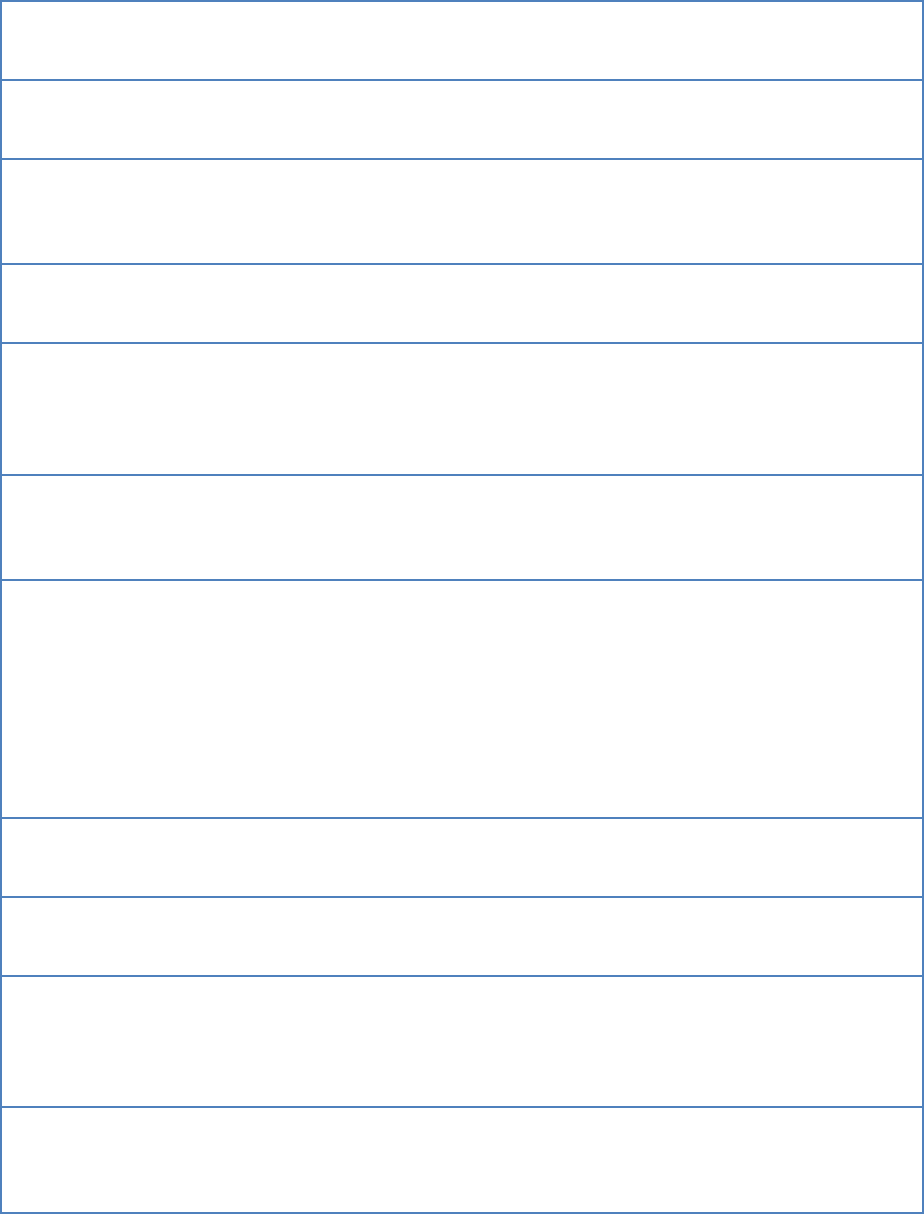
Health & Safety Guide for Operators of Child Care Facilities
34
Safe Healthy Environments - Environmental Public Health – May 2024
Epoxy, instant glue, airplane glue, or other
solvent-based adhesives.
Water-based white glue or library paste.
Permanent felt-tip markers which may contain
toxic solvents.
Water-based markers only.
Casting plaster. Besides creating dust, casting
body parts can result in serious burns.
Adults can mix plaster in a ventilated
area or outdoors for sand casting and
other safe projects.
Toxic bingo dabbers Bingo dabbers that state they are non-
toxic.
Objects that are small enough to lodge in a
child’s ear or nose or that may cause a choking
hazard for children under 3. Styrofoam may be a
choking hazard for young children.
Larger, non-toxic craft objects.
Toxic crayons or ones broken into small pieces.
For children under the age of 3, broken crayons
may be a choking hazard.
Use waxed or pressed crayons designed
for children that are non-toxic.
Egg cartons with visible dirt on them. Clean egg cartons can be purchased at
craft stores or ask a local egg processor
to donate unused egg cartons. If the
children are bringing products from
home, styrofoam cartons are preferred
over cardboard cartons. Spray
styrofoam cartons with a 100 ppm
chlorine solution.
Products not designed for use on the body for
body art and face painting.
Products designed for use on the body.
Scissors that have sharp points. Use safety scissors or children’s scissors
with blunt ends.
Leaves and straw may have residual chemicals,
be infested with insects, or contain bacteria,
mould or dust that may cause problems for
children with allergies.
Eggshells from raw eggs. Eggshells immersed in boiling water or
heated in the oven for at least 10 minutes
at 175°C (350°F).
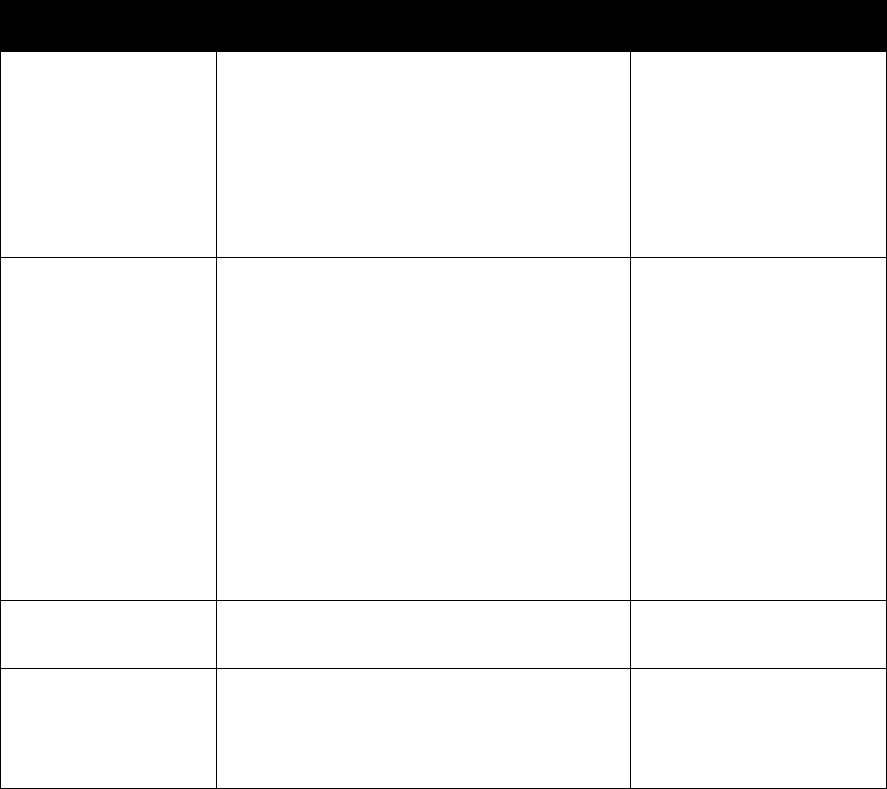
Health & Safety Guide for Operators of Child Care Facilities
35
Safe Healthy Environments - Environmental Public Health – May 2024
Appendix F - Cleaning & Disinfecting Surfaces, Equipment & Toys
For toys not cleaned and disinfected in an approved dishwasher follow the steps below.
1. Wash with detergent and warm water.
2. Rinse detergent away with clean, warm water.
3. Wipe, spray, or keep item submerged in a sink for 2 minutes in an approved disinfectants
4. After sanitizing step, let the surface or item air dry.
5. Toys that are washed by sink method, and are likely to be mouthed should have a potable
water rinse.
Approved Sanitizer
How to Mix
Solution Strength
Chlorine Solution
• 2 ml (1/2 teaspoon) household bleach
per litre (4 cups) of water
100 ppm Chlorine for
toys, food surfaces and
other high touch
environmental surfaces.
Quaternary Ammonia
Solution (QUATS)
Follow manufacturer’s instructions for
mixing correct concentration and for the
concentration required for environmental
surfaces. Product must have a DIN (Drug
Identification Number) issued by Health
Canada.
Products should have a broad spectrum
virucidal claim OR a virucidal claim against
non-enveloped viruses or coronaviruses.
Follow manufacturer’s
instructions
Iodine Solution Follow manufacturer’s instructions 12.5 – 25 PPM Iodine
Accelerated
Hydrogen Peroxide
Follow manufacturer’s instructions for
mixing the correct concentration. Product
must have a DIN issued by Health Canada.
0.5%AHP (with
disinfectant claim)
Disinfectant concentration must be tested regularly with sanitizer test papers or other testing
equipment unless the sanitizer or disinfectant is premixed by the manufacturer and marked with
an expiry date.

Health & Safety Guide for Operators of Child Care Facilities
36
Safe Healthy Environments - Environmental Public Health – May 2024
Appendix G – Cleaning & Disinfecting Schedule for Child Care Facilities
Classrooms/Child Care/Food Areas
Area
Clean
Disinfect
Frequency and Comments
Activity centres, play mats, larger
toys, riding toys, dry play tables
x x Weekly and when soiled.
Carpets and large area rugs x
Vacuum daily when children are not
present. When deep cleaning
carpets, make sure children are not
present until the carpet is dry. Deep
clean carpets at least monthly in
infant areas, at least every three
months in other areas, and when
soiled.
Chairs
x
x
Weekly and when soiled.
Combs and hairbrushes x x
Weekly, before use by a different
child, and whenever soiled.
Countertops, tables, floors, light
switches, doors, and cabinet
handles
x x Daily and when soiled.
Crib rails, shelves and infant and
toddler level furniture
x x Twice weekly.
Cribs and crib mattresses x
Weekly, before use by a different
child, and whenever wet or soiled.
Cubbies
x
Monthly and when soiled.
Cushions and pillows used in
activities areas
x Launder weekly and when soiled.
Door ledges and shelving x
Damp-wipe monthly and when
soiled.
Drapes and curtains x
Vacuum monthly and when soiled.
Launder or dry clean yearly.
Dress up clothes (not worn on the
head- see “Hats” below) and
soft/plush toys
x Weekly and when soiled.
Floor mats and small rugs
x
Shake outdoors or vacuum daily.
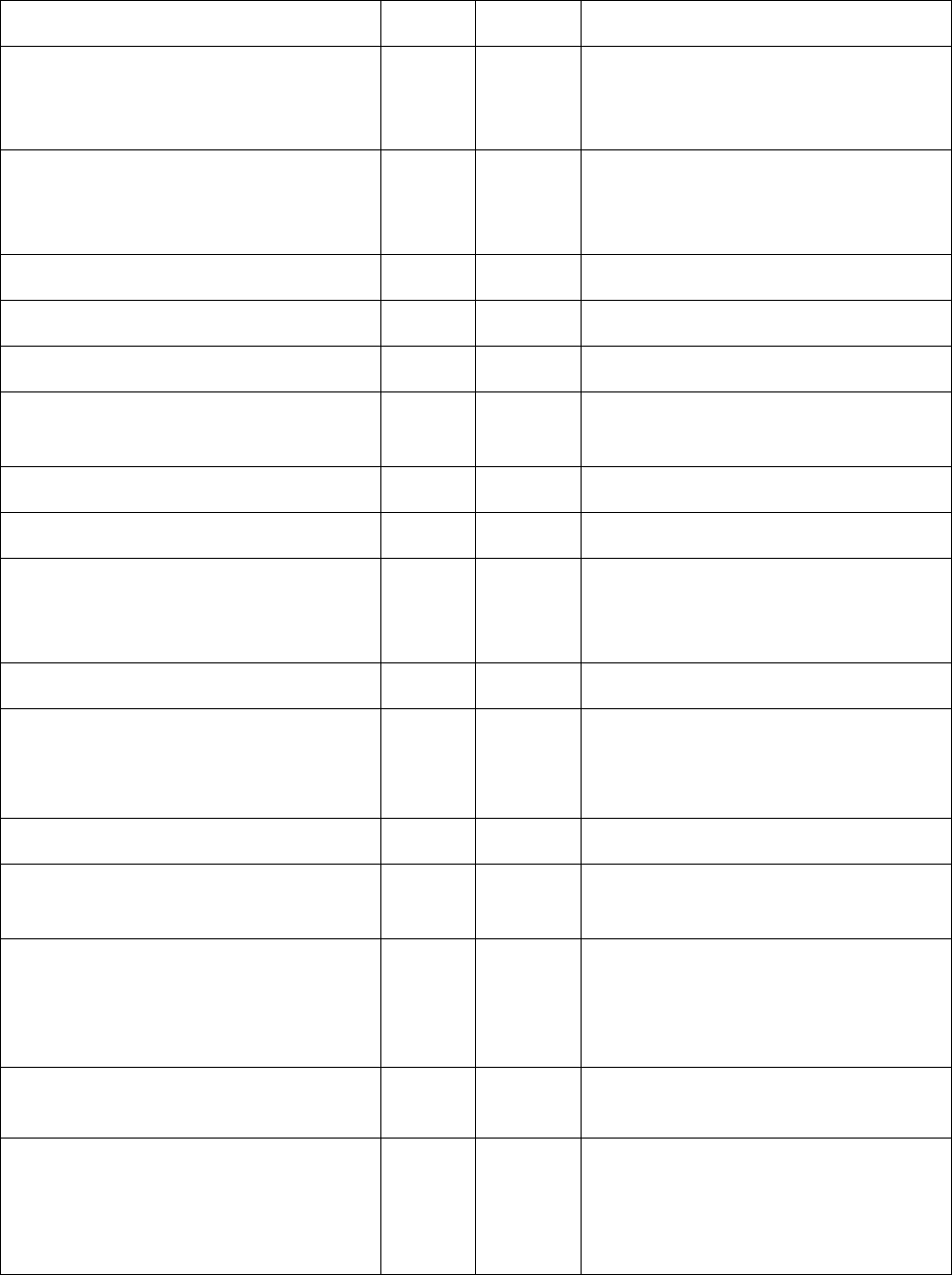
Health & Safety Guide for Operators of Child Care Facilities
37
Safe Healthy Environments - Environmental Public Health – May 2024
Floors
x
x
Daily and when soiled.
Food preparation/service equipment
and surfaces
x x
Before and after contact with food
activity; between preparation of raw
and ready-to-eat foods.
Hats x
After each child's use or use
disposable hats that only one child
wears.
Highchairs and plastic bibs
x
x
Daily and when soiled.
Pet areas
x
x
Weekly.
Phone receivers
x
x
Weekly
Refrigerators and ovens x x
Monthly and when soiled. Clean out
freezer every six months.
Sand table
x
Weekly and when soiled.
Shared puzzles and board games
x
Weekly and when soiled.
Sheets, pillowcases, blankets,
individual cloth towels (if used)
x
Laundered weekly, before use by a
different child, and whenever wet or
soiled.
Sofas and chairs (upholstered)
x
Vacuum weekly and when soiled.
Soothers x x
Reserve for use by one child only.
Sanitize in boiling water, or use an
approved dishwasher.
Toys for sand tables
x
x
Daily and when soiled.
Toys that are not contaminated with
bodily fluids
x Weekly and when soiled.
Toys, utensils, and surfaces that go
into the mouth or have been in
contact with saliva or other body
fluids
x x
After each child's use, or use
disposable, single use items. Use
food grade cleaners and sanitizers.
Water tables and toys x x
Twice daily (midday and end of the
day).
Windows x
Twice a year or as needed.

Health & Safety Guide for Operators of Child Care Facilities
38
Safe Healthy Environments - Environmental Public Health – May 2024
Toilet and Diapering Areas
Area
Clean
Disinfect
Frequency and Comments
Changing tables, potty chairs
x x After each child's use.
Hand washing sinks, faucets,
surrounding counters, soap
dispensers, door knobs
x x Daily and when soiled.
Toilet bowls x x Daily.
Toilet seats, toilet handles, door
knobs or cubicle handles, floors
x x
Daily or immediately if visibly
soiled.
General Facility
Area
Clean
Disinfect
Frequency and Comments
Air vents
x
Vacuum monthly and when soiled.
Any surface contaminated with body
fluids: saliva, mucus, vomit, urine,
stool or blood
x x Immediately.
Humidifiers x x
Drained and cleaned daily. Sanitize
weekly.
Mops and cleaning rags
x
x
After a day of use or as needed.
Waste and diaper containers x
Empty daily and as needed. Clean
weekly or as needed.
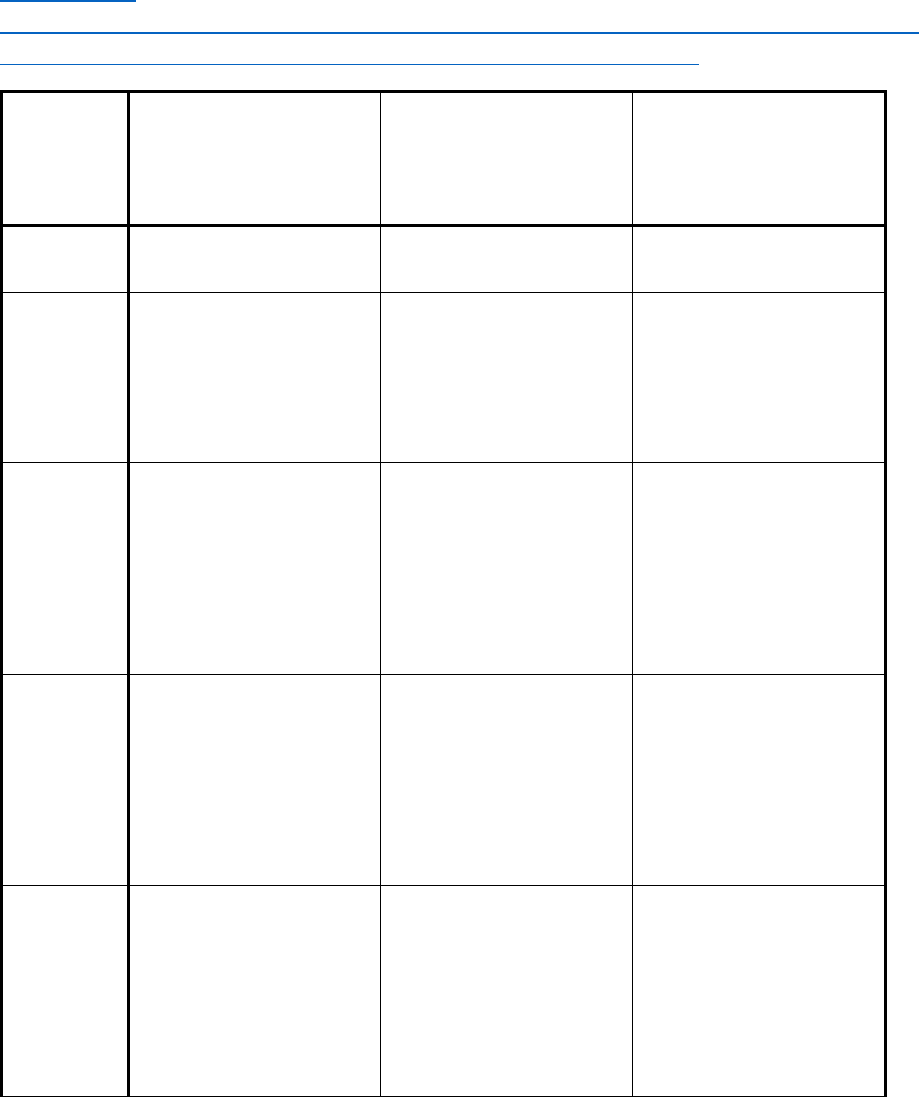
Health & Safety Guide for Operators of Child Care Facilities
39
Safe Healthy Environments - Environmental Public Health – May 2024
Appendix H – First Aid Equipment & Supplies
First Aid Requirements for medium hazard work
(adapted from Occupational Health and Safety Code, AR 191/2021 (Table 6))
https://kings-
printer.alberta.ca/Documents/MinOrders/2022/Jobs_Economy_and_Northern_Develop
ment/2022_001_Jobs_Economy_and_Northern_Development.pdf
Number of
workers at
work site
per shift
Close work site
(up to 20 minutes)
Distant work site
(20 – 40 minutes)
Isolated work site
(more than 40 minutes)
1
CSA Standard Z1220-17
Type 1 Personal First Aid Kit
CSA Standard Z1220-17
Type 1 Personal First Aid Kit
CSA Standard Z1220-17
Type 1 Personal First Aid Kit
2 – 9
1 Basic First Aider
CSA Standard Z1220-17
Type 2 Basic Small First Aid
Kit
1 Intermediate First Aider
CSA Standard Z1220-17
Type 2 Basic Small First Aid
Kit
3 blankets
1 Intermediate First Aider
CSA Standard Z1220-17
Type 2 Basic Small First Aid
Kit
3 blankets
10 – 19
1 Basic First Aider
1 Intermediate First Aider
CSA Standard Z1220-17
Type 2 Basic Small First Aid
Kit
1 Basic First Aider
1 Intermediate First Aider
CSA Standard Z1220-17
Type 2 Basic Small First Aid
Kit
3 blankets
2 Intermediate First Aider
CSA Standard Z1220-17
Type 2 Basic Small First Aid
Kit
3 blankets
20 – 49
1 Basic First Aider
1 Intermediate First Aider
CSA Standard Z1220-17
Type 2 Basic Medium First
Aid Kit
1 Basic First Aider
1 Intermediate First Aider
CSA Standard Z1220-17
Type 2 Basic Medium First
Aid Kit
3 blankets
2 Intermediate First Aider
CSA Standard Z1220-17
Type 2 Basic Medium First
Aid Kit
3 blankets
50 – 99
2 Basic First Aider
1 Intermediate First Aider
CSA Standard Z1220-17
Type 2 Basic Large First Aid
Kit
2 Basic First Aider
1 Intermediate First Aider
CSA Standard Z1220-17
Type 2 Basic Large First Aid
Kit
3 blankets
3 Intermediate First Aider
CSA Standard Z1220-17
Type 2 Basic Large First Aid
Kit
3 blankets

Health & Safety Guide for Operators of Child Care Facilities
40
Safe Healthy Environments - Environmental Public Health – May 2024
Number of
workers at
work site
per shift
Close work site
(up to 20 minutes)
Distant work site
(20 – 40 minutes)
Isolated work site
(more than 40 minutes)
100 – 199
2 Basic First Aider
2 Intermediate First Aider
CSA Standard Z1220-17
Type 2 Basic Large First Aid
Kit
Designated area for first aid
services
2 Basic First Aider
2 Intermediate First Aider
CSA Standard Z1220-17
Type 2 Basic Large First Aid
Kit
3 blankets, stretcher, splints
Designated area for first aid
services
3 Intermediate First Aider
1 Advanced First Aider
CSA Standard Z1220-17
Type 2 Basic Large First Aid
Kit
3 blankets, stretcher, splints
Designated area for first aid
services
200 or more
2 Basic First Aider
2 Intermediate First Aider
1 nurse who holds an
advanced first aid certificate
or 1 advanced care
paramedic
Plus
1 intermediate First Aider for
each additional increment of
1 to 100 workers
First Aid Room for workers
2 Basic First Aider
2 Intermediate First Aider
1 nurse who holds an
advanced first aid certificate
or 1 advanced care
paramedic
Plus
1 intermediate First Aider for
each additional increment of
1 to 100 workers
First Aid Room for workers
4 Intermediate First Aider
1 nurse who holds an
advanced first aid certificate
or 1 advanced care
paramedic
Plus
1 intermediate First Aider for
each additional increment of
1 to 100 workers
First Aid Room for workers
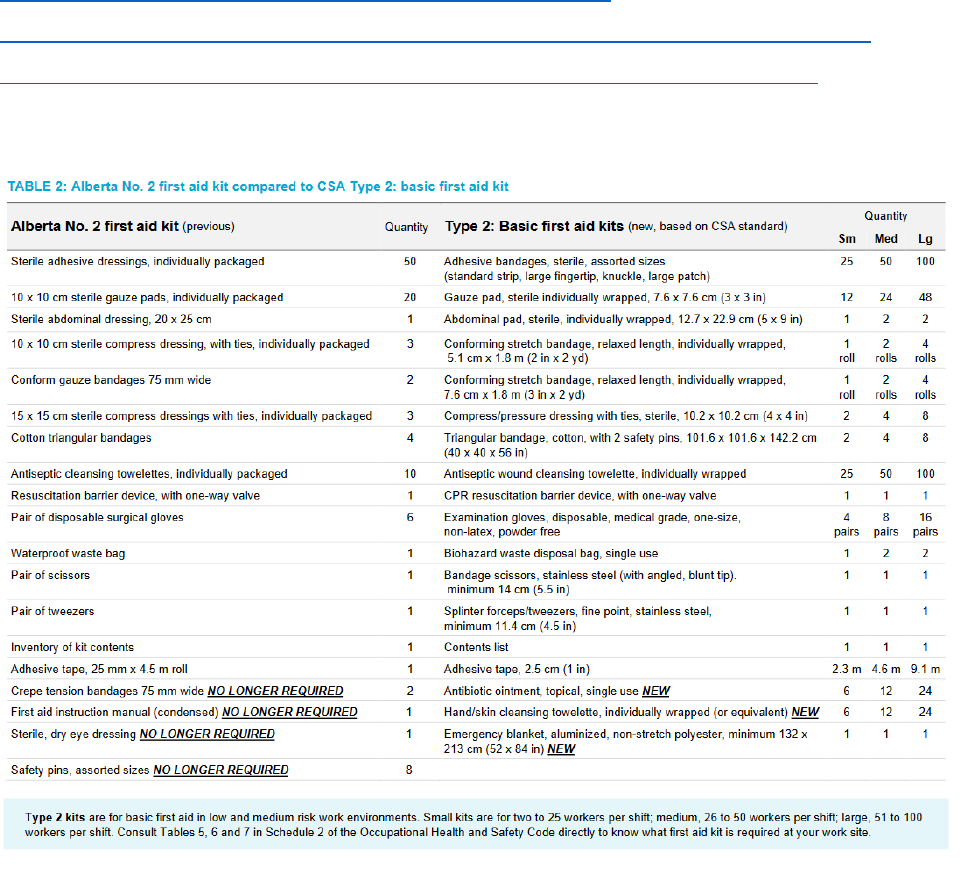
Health & Safety Guide for Operators of Child Care Facilities
41
Safe Healthy Environments - Environmental Public Health – May 2024
Change highlights: First Aid – Part 11 in the OHS Code (May 2023):
https://open.alberta.ca/dataset/c56f65df-8dba-44ce-bdc6-
1238ab3bf7b6/resource/4bda3db2-4b35-4c0e-bd49-56cac1a8f8fb/download/jend-
ohsorp-lh001-change-highlights-first-aid-part-11-in-the-ohs-code-2023-05.pdf
Health & Safety Guide for Operators of Child Care Facilities
42
Safe Healthy Environments - Environmental Public Health – May 2024
Appendix I – Cleaning & Disinfecting Blood Spills, Feces, Vomit & Other
Body Fluids
Staff must treat all body fluid spills carefully, as there is a hazard of infectious disease.
All the materials used to clean the body fluid spill (e.g., rags, brushes, gloves, etc.) must
also be treated as infectious and handled with care.
Only allow staff that know these clean-up procedures to clean a body fluid spill.
Before cleaning begins, a staff person needs to supervise the area that is affected by
the body fluid spill. This is to make sure the public and other staff do not enter the
affected area.
A hazard remains until the entire contaminated area has been properly cleaned and
disinfected, and contaminated materials including the cleaning equipment that was used
have been disposed of safely.
Materials Needed
• Gloves
• Other personal protective equipment such as a mask, eye goggles, coveralls and
booties
• Paper towel or disposable rags
• Bleach solution (1 part bleach to 9 parts water)
• Leak-proof garbage bag
• Sanitizer test strips
A. Cement and Non-absorbent Surfaces
1. Wear gloves (preferably disposable) made with non-absorbent material (e.g., latex, vinyl,
rubber) to protect your hands. Do not use torn gloves, and avoid tearing your gloves on
equipment or sharp objects. Use additional protection such as face shield, goggles, or
disposable apron, as needed, to protect personal clothing, skin, lips, and eyes.
2. Blot any excess body fluid using paper towels or disposable rags/cloths. Do not use a
mop because they are difficult to properly clean afterward, and there may be possible
splashing of body fluids.
3. Use a bleach solution to disinfect the area (1 part household 5.25% bleach to 9 parts
water). Pour enough of the bleach solution over the affected area so that the area is wet
with the solution, and let the solution sit for a minimum of 10 minutes.
4. Soak up the bleach solution with fresh paper towels or disposable rags/cloths.
5. Place all used paper towels or rags/cloths in a leak-proof garbage bag. If disposable
gloves are used, remove and discard the gloves and other protective equipment at this
point. Dispose of the plastic bag into the regular trash.
6. After cleaning and disinfecting the area, wash hands thoroughly with soap and water.
Health & Safety Guide for Operators of Child Care Facilities
43
Safe Healthy Environments - Environmental Public Health – May 2024
B. Carpet
If the spill occurs in a carpeted area, using bleach might cause discoloration of the
carpet. Another non-staining disinfectant is recommended to clean the carpet (see
Alternative Disinfectants below). If the spill is heavy, you might want to replace the
affected area of the carpet and underlay. Steam cleaning of the affected materials is also
acceptable.
C. Precautions for Cleaning and Disinfecting
1. Bleach is corrosive. It may damage colored fabrics or corrode some surfaces unless
rinsed off.
2. Bleach should only be used in well-ventilated areas, and care should be taken to
avoid exposure to skin, eyes and mucous membranes.
D. Alternative Disinfectants
Alternative disinfectants such as 0.5% accelerated hydrogen peroxide compounds can
be used to clean blood and other body fluids. Disinfectants must have a drug
identification number (DIN) issued by Health Canada.
The contact time and mixing instructions for cleaning blood and fluids issued by the
manufacturer must be followed. Contact time is essential. Often, merely spraying and
wiping or letting the disinfectant air-dry will not ensure sufficient contact time.
Note that sanitizer concentrations must be tested regularly with sanitizer test papers or
other testing equipment.

Health & Safety Guide for Operators of Child Care Facilities
44
Safe Healthy Environments - Environmental Public Health – May 2024
Appendix J – Additional Guidelines for Day Homes
Day homes are places where child care services are offered in a caregiver’s own home.
Follow this checklist of best practices for day home providers to operate a day home
safely. The following items are mandatory, except where noted as a recommendation.
Keep children safe
☐ Keep a basic (Type P) first aid kit available in the home and on field trips. Contents
are outlined in the Alberta OHS Code - OHS Act, Regulation and Code | Alberta.ca.
☐ Cover electrical outlets with approved safety covers.
☐ Secure dangling cords from blinds and other window coverings, and secure
electrical cords away from children’s reach.
☐ Secure televisions, shelving, dressers, and other furniture to prevent it from falling
on a child.
☐ Lock away chemicals, medications, and other dangerous objects.
☐ To prevent scalding, keep hot water temperature for baths and showers at or below
49C (recommended 43C). Keep all other hot water taps at or below 54C
(recommended 49C).
☐ Keep area around hot water tank free of clutter and combustibles.
☐ Prevent children’s access to the laundry room.
☐ Remove dangerous objects from the yard and around the home. Consider toxicity
of plants - https://myhealth.alberta.ca/Alberta/Pages/non-toxic-and-toxic-plants-in-
alberta.aspx
☐ Identify and repair tripping or fall hazards throughout your home (examples: stairs,
uneven flooring, loose carpet, slippery floors). Keep gates secured at the top and
bottom of all accessible stairways.
☐ Verify that baby furniture and toys meet Health Canada’s safety standards -
http://www.hc-sc.gc.ca/cps-spc/index-eng.php.
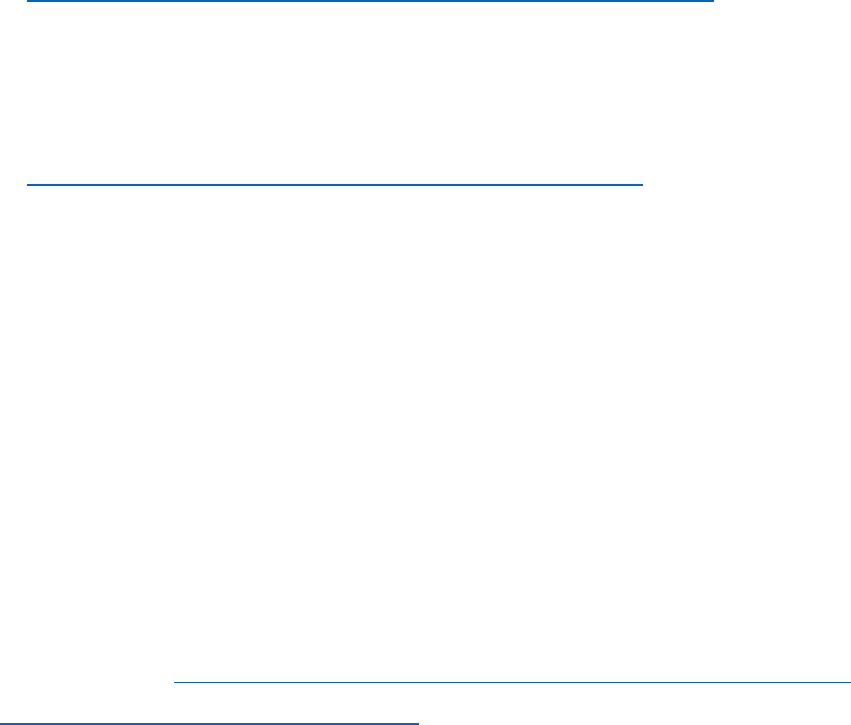
Health & Safety Guide for Operators of Child Care Facilities
45
Safe Healthy Environments - Environmental Public Health – May 2024
Recommendations
Supervise the use of any outdoor pools. Provide safety equipment for pool
(examples: throwing ring, reach pole). Complete a course in pool operation and
maintenance.
Provide a puncture proof container for sharps disposal, if needed.
Review a fire evacuation plan with children. Maintain fire extinguishers, smoke
detectors and carbon monoxide detectors in good working condition.
Clean and service furnace every 2 years.
Generally, keep children out of the kitchen. Supervise them when they do use it.
Do not use trampolines
https://myhealth.alberta.ca/Alberta/Pages/trampoline-safety.aspx
Install and maintain protective fall surfacing under and around play structures -
Eliminate entrapment, entanglement and protrusion hazards on play equipment.
Complete a course in basic health & safety for child care-
https://www.albertahealthservices.ca/eph/Page3151.aspx.
Prevent the spread of disease
☐ Provide hand soap and single use towels for handwashing.
☐ Keep toilets and sinks clean and in good condition.
☐ Keep beds, cribs, cots or mats sanitary and in good condition.
Machine wash bed linens between uses by children and/or household members.
☐ Space mats apart while children are sleeping.
☐ Have sanitizer or low-level disinfectant available. Clean and sanitize surfaces,
equipment and toys. For directions, use Health and Safety Guidelines for Child
Care Facilities - http://www.albertahealthservices.ca/assets/wf/eph/wf-eh-health-
safety-guidlines-child-care-facilities.pdf.

Health & Safety Guide for Operators of Child Care Facilities
46
Safe Healthy Environments - Environmental Public Health – May 2024
☐ Provide a separate space for diapering children. Follow proper diapering
procedures and practices - https://www.albertahealthservices.ca/assets/wf/eph/wf-
eph-diapering-procedure-poster.pdf.
☐ Protect your home from mice, flies and other pests.
Choose a supervised area to separate a child that is ill from the rest of the
children. Arrange to have the child picked up as soon as possible.
Recommendations
Test sanitizer strength with a test strip before use.
Avoid placing clean laundry in baskets used for dirty laundry. Label baskets “For
clean laundry only”.
Avoid contact between toothbrushes, hair combs, and brushes. Each item should
be stored separate from one another.
Use individual separate wash cloths and towels for each child.
Wash hands after touching animals, animal waste, or any related animal
supplies.
Take animals to routine vet examinations and vaccination.
